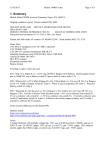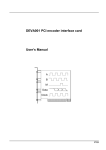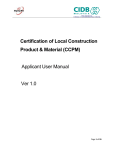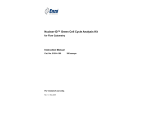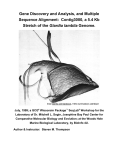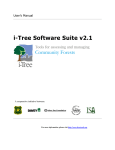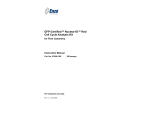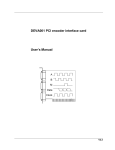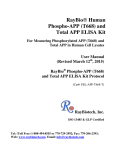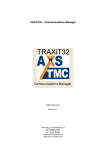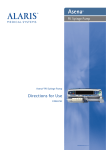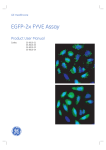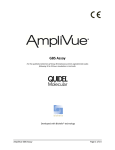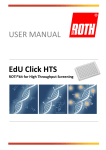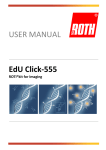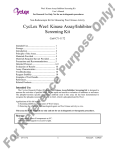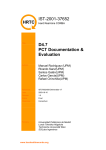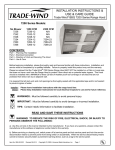Download G1S Cell Cycle Phase Marker Assay—User Manual
Transcript
25-9003-97UM Rev A 2005 24/8/05 12:14 Page 1 G1S Cell Cycle Phase Marker Assay—User Manual 25-9003-97UM Secondary information. 25-9003-97 Screening Applications 25-9003-98 Research Applications 25-9003-99 6 month evaluation 25-9004-00 12 month evaluation 25-9004-01 Non-profit research 0h - G2 1h - M 1h30m – early G1 2h - G1 2h30min - G1 4h – G1/S 7h30m - S 21h - G 2 24h - M 25-9003-97UM Rev A 2005 24/8/05 12:14 Page 2 Front cover: Time lapse images of an asynchronous population of U-2 OS cells exhibiting stable expression of the G1S Cell Cycle Phase Marker (G1S CCPM). After mitosis and cell division lasting approximately 1 hour, there is a phase of 2–5 hours where the sensor exhibits predominantly nuclear distribution. Rapid changes in subcellular distribution associated with this phase are indicative of high Cdk2/cyclin E activity. The sensor then demonstrates a phase of progressive export from the nucleus over the following 10–14 hours, and a phase of 2–5 hours when it is exclusively cytoplasmic. The length of each of these phases correlates with the reported lengths of M, G1, S and G2-phases for rapidly dividing U-2 OS cells. Elapsed time and phase are indicated on each image. Images were acquired on the IN Cell Analyzer 3000 (GE Healthcare). 25-9003-97UM Rev A 2005 2 25-9003-97UM Rev A 2005 24/8/05 12:14 Page 3 Contents 1. Introduction 6 1.1. The Cell Cycle 6 1.2. Cell Cycle Phase Markers (CCPM) 6 1.2.1. Human helicase B 6 1.2.2. Ubiquitin C promoter 7 1.2.3. The G1S CCPM sensor 7 1.3. Applications in drug discovery 9 2. Licensing considerations 10 2.1. Licensing considerations 10 2.2. Legal 10 3. Product contents 11 3.1. Components summary 11 3.2. GFP expression vector pCORON1002-EGFP-C1-PSLD 11 3.3. Clonal U-2 OS cells exhibiting stable expression of the G1S CCPM 11 3.3.1. U-2 OS parental cell line 11 3.3.2. Production of clonal U-2 OS cells exhibiting stable expression of the G1S CCPM 11 3.4. Materials and equipment 11 3.5. Software requirements 12 3.5.1. IN Cell Analyzer 3000 G1S Cell Cycle Trafficking Analysis Module 12 3.5.2. IN Cell Analyzer 1000 G1S Cell Cycle Trafficking Analysis Module 12 3.5.3. Confocal or epifluorescence microscopes 12 3.5.4. IN Cell Image Converter 123 12 4. Safety warnings, handling and precautions 13 4.1. Safety warning 13 4.2. Storage 13 4.3. Handling 13 4.3.1. Vector 13 4.3.2. Cells 13 5. Cell assay design 14 5.1. Culture and maintenance of U-2 OS cell line exhibiting stable expression of the G1S CCPM 14 5.1.1. Tissue culture media and reagents required 14 5.1.2. Reagent preparation 14 5.1.3. Cell thawing procedure 15 5.1.4. Cell sub-culturing procedure 15 5.1.5. Cell seeding procedure 16 5.1.6. Cell cryopreservation procedure 16 25-9003-97UM Rev A 2005, Pagefinder 3 25-9003-97UM Rev A 2005 24/8/05 12:14 Page 4 5.1.7. Growth characteristics 16 5.2. Assay set up 17 5.2.1. General Assay Set up 17 5.2.2. G1S CCPM fixed-cell assay procedure 17 5.2.2.1. G1S cell cycle synchronization using Roscovitine 18 5.2.2.2. G2M cell cycle synchronization using Nocodazole 18 5.2.3. G1S CCPM live-cell end-point assay procedure 19 5.2.4. G1S CCPM live-cell kinetic procedure 19 5.3. Imaging on IN Cell Analysis Systems 19 5.3.1. IN Cell Analyzer 3000 19 5.3.1.1. Fixed-cell imaging of G1S CCPM on the IN Cell Analyzer 3000 19 5.3.1.2. Live-cell end-point imaging of G1S CCPM on the IN Cell Analyzer 3000 20 5.3.1.3. Live-cell kinetic imaging of G1S CCPM on IN Cell Analyzer 3000 20 5.3.1.4. Analysis using the IN Cell Analyzer 3000 21 5.3.2. IN Cell Analyzer 1000 21 5.4. Performing cell cycle phase marker assays on epifluorescence microscopes 22 5.5. G1S CCPM sensor and assay characterization 23 5.5.1. G1S CCPM fixed-cell assay Roscovitine dose response 23 5.5.2. G1S CCPM fixed-cell assay Nocodazole dose response 24 5.5.3. G1S CCPM live-cell end-point assay Roscovitine dose response 24 5.5.4. G1S CCPM live-cell end-point assay Nocodazole dose response 25 5.5.5. Multiplexing the G1S CCPM with a marker of DNA replication activity. 25 5.5.5.1. G1S CCPM fixed-cell assay multiplexed with Cell Proliferation Fluorescence Assay to produce Roscovitine dose response 27 5.5.5.2. G1S CCPM fixed-cell assay multiplexed with Cell Proliferation Fluorescence Assay to produce Nocodazole dose response 28 5.5.5.3. Imaging the G1S CCPM assay multiplexed with Cell Proliferation Fluorescence Assay on the IN Cell Analyzer 1000 28 5.5.6. Characterisation of G1S CCPM with inhibitors of the cell cycle 29 5.5.7. Correlation between sub-cellular distribution of G1S CCPM and DNA complement 30 6. Vector use details 32 6.1. General guidelines for vector use 32 6.2. Transfection with pCORON1002-EGFP-C1-PSLD 32 6.2.1. FuGENE 6 Transfection Reagent protocol 32 6.3. Stable cell line generation with pCORON1002-EGFP-C1-PSLD 32 7. Quality control 33 7.1. pCORON1002-EGFP-C1-PSLD expression vector 33 7.2. Cell cycle position reporting cell line 33 8. Troubleshooting guide 34 8.1. Troubleshooting 25-9003-97UM Rev A 2005, Pagefinder 34 4 25-9003-97UM Rev A 2005 24/8/05 12:14 Page 5 9. References 35 9.1. References 35 10. Related products 36 10.1 Related products 36 11. Appendix 37 11.1. Restriction map of pCORON1002-EGFP-C1-PSLD 25-9003-97UM Rev A 2005, Pagefinder 37 5 25-9003-97UM Rev A 2005 24/8/05 12:14 Page 6 1. Introduction 1.1. The Cell Cycle 1.2. Cell Cycle Phase Markers (CCPM) Eukaryotic cell division (Figure 1.1.) proceeds through a highly regulated cell cycle comprising the consecutive phases: gap1 (G1), synthesis (S), gap 2 (G2) and mitosis (M). In a normal cell, progress from one phase to the next (and within phases) is controlled by the activation and deactivation of a series of proteins that constitute the cell cycle machinery. Signal transduction pathways couple the detection of DNA damage to the cell cycle machinery at specific checkpoints whilst additional pathways couple the cell cycle machinery to the detection of external factors. This elaborate and ordered control of the cell cycle and its checkpoint mechanisms ensures tight regulation in response to cellular and environmental factors, and maintains genomic integrity by arresting progress or inducing destruction of aberrant cells. GE Healthcare has previously demonstrated the use of functional elements from the cyclin B1 promoter and gene in the development of a live cell, non-perturbing sensor of G2- and M-phases of the cell cycle termed, the G2M Cell Cycle Phase Marker (G2M CCPM; Product code 25-8010-50). The G2M CCPM sensor is switched on in late S phase, switched off at the end of mitosis and in the intervening period (during prophase) translocates from the cytoplasm to the nucleus. Cyclin D G0 Cdk4/6 Cyclin E Cdk2 Rb E2F Cyclin B The Cell Cycle Phase Markers (CCPM) are non-perturbing fluorescent protein-based sensors that provide an indication of the cell cycle status of individual cells in an asynchronous population. They can be used in live cells with kinetic imaging systems to provide a dynamic, non-invasive method of monitoring the cell cycle, or in end-point format with other probes to highlight complex cell cycle related events. P The current G1S Cell Cycle Phase Marker (G1S CCPM) has been developed using functional elements from the human helicase B gene and human ubiquitin C promoter (Figure 1.2.). The G1S CCPM provides a live cell, non-perturbing sensor of Cdk2/cyclin E activity and is an indicator of G1- and S-phases of the cell cycle. In conjunction with fluorescence microscopy the G1S CCPM can indicate the phase-specific cell cycle position of individual cells within an asynchronous population. Rb E2F M E2F Cyclin A P Cdk1 P Rb G1 Cyclin B Cdk1 G2 Cyclin A Cyclin B 1.2.1. Human helicase B Cdk2 The human homolog of helicase B was first reported in 2002 (2). The 1087 amino acid protein comprises three regions; an uncharacterised N-terminal region, a central helicase domain containing seven conserved motifs of the helicase superfamily I and a C-terminal location control element (Figure 1.2.). Helicase B displays strong ATPase activity in the presence of single stranded DNA and exhibits 5’-3’ DNA helicase activity dependent upon Walker A and B motifs. Helicase B associates physically and functionally with DNA polymerase α-primase and mutational studies have shown that enzyme activity is essential for G1/S transition of the cell cycle. Gu et al (3) have demonstrated that the protein is localized at nuclear foci induced by DNA damage, and have indicated that helicase B operates primarily in G1 to process endogenous DNA damage prior to the G1/S transition. Cdk1 Cyclin A S Cdk1 Figure 1.1. The distinct phases of the cell cycle are controlled through the interaction of cyclins, cyclin dependent kinases and their inhibitors. Cells that are quiescent or resting are in G0-phase. A G0-phase cell can be stimulated to re-enter the cell cycle through exposure to a range of external factors, such as mitogens via the mitogen activated protein kinase cascade. During G1-phase cells prepare for DNA replication and pass through a checkpoint for DNA integrity prior to S-phase. In S-phase the genome is replicated and centrosomes are duplicated. Once DNA replication has been completed the cell enters G2-phase where proteins required for mitosis are synthesised and final checks on the integrity of the DNA are made. Mitosis involves chromosome condensation, alignment and sister chromatid migration which occur prior to the physical division of the cell into two daughters, a process known as cytokinesis. 25-9003-97UM Rev A 2005, Chapter 1 Consistent with the proposed action of helicase B, the protein resides in the nucleus of G1-phase cells but is predominantly cytoplasmic in S- and G2-phase cells. Gu et al (3) have demonstrated that a 131 amino acid C-terminal phosphorylation dependent subcellular localisation control domain (PSLD) of helicase B is portable and contains active targeting signals that are independent of protein context. The PSLD contains a nuclear localisation sequence (NLS), a 6 25-9003-97UM Rev A 2005 24/8/05 12:14 Page 7 rev-like nuclear export sequence (NES) and seven putative cyclin dependent kinase (Cdk) phosphorylation sites (Figure 1.2.). Phosphopeptide mapping demonstrated that, of the seven putative phosphorylation sites, serine 967 is the primary site of phosphorylation by Cdks in vivo and in vitro. In addition, the phosphorylation of S967 is coincident with G1/S transition and is maintained throughout S-, G2- and M-phases, whilst mutation of S967 showed this residue to be crucial to the cell cycle phase-specific subcellular localisation of the protein. Both, Cdk2/cyclin A and Cdk2/cyclin E complexes can phosphorylate S967 of helicase B in vitro, but Cdk2/cyclin E has been shown to be the predominant complex with ectopically expressed helicase B in asynchronous cell extracts. 1.2.2. Ubiquitin C promoter The human ubiquitin C promoter is highly active in many mammalian tissues and has been reported to provide the most reliable expression in a range of cell types (4, 5). Expression levels generated by the ubiquitin C promoter are around one half to one third the levels obtained with the CMV I/E promoter (dependent upon the cell type) but the ubiquitin C promoter has been shown to be less prone to tissue specific or temporal inactivation. 1.2.3. The G1S CCPM sensor The G1S CCPM sensor is a fusion of the human helicase B PSLD region to the C-terminus of EGFP (Figure 1.2.). The sensor contains an amino acid linker region that permits flexibility between the two component peptides facilitating access of the cell cycle machinery to the PSLD. The linker also increases the overall size of the sensor above 40kDa precluding passive diffusion across the nuclear membrane (6). Therefore, the sensor must be actively transported from the nucleus resulting in a precise indication of cell cycle progress. Gu et al (3) concluded that in G1-phase cells S967 of human helicase B is dephoshorylated, the NLS is exposed, the NES is masked and therefore the protein is predominantly distributed in the nucleus. However, late in G1-phase S967 becomes phosphorylated by increasing levels of active Cdk2/cyclin E complex resulting in the unmasking of an NES and nuclear to cytoplasmic translocation of the protein. Walker sites 1 S967 HDHB The ubiquitin C promoter is included in the plasmid vector construct that has been used in the production of clonal U-2 OS cells exhibiting stable expression of the G1S CCPM sensor since low, homogeneous and consistent levels of ectopic expression are desirable in order to minimize perturbation of host cell systems and produce an assay that is stable and robust. 1087 PSLD S967 NES Characterisation of a clonal U-2 OS cell line exhibiting stable expression of the G1S CCPM on the IN Cell Analyzer 3000 has demonstrated that the subcellular distribution of the sensor and other cellular characteristics can be used to indicate up to 4 separate phases of the cell cycle (see front cover, Figure 1.3., Figure 1.4. and Chapter 5). After mitosis and cell division lasting 1 to 1.5 hours, there is a phase of 2–5 hours where the sensor exhibits predominantly nuclear distribution. Rapid changes in sub-cellular distribution associated with this phase are indicative of increasing Cdk2/cyclin E activity. The sensor demonstrates a slower progressive export from the nucleus over the following 10–14 hours, and a period of 2–5 hours when it is exclusively cytoplasmic. The length of each of these phases correlates with the reported lengths of G1, S, G2 and Mphase for rapidly dividing U-2 OS cells. G1 NLS Cyclin E CDK2 S967-P NES S NLS UbC EGFP PSLD Figure 1.2. Schematic of human helicase B and development of the G1S CCPM sensor containing the phosphorylation dependent subcellular localisation control domain (PSLD). In late G1-phase S967 of human helicase B is phosphorylated by the Cdk2/cyclin E complex (putative CDK phosphorylation sites are shown in yellow). This event is thought to unmask a rev-type nuclear export sequence (NES) resulting in translocation of the endogenous protein from the nucleus to the cytoplasm around the G1/S boundary. The G1S CCPM sensor is a fusion of the helicase B PSLD region to the Cterminus of EGFP (via a short flexible amino acid linker region). The sensor is expressed from the human ubiquitin C promoter (UbC). 25-9003-97UM Rev A 2005, Chapter 1 7 25-9003-97UM Rev A 2005 24/8/05 12:14 Page 8 G2 Cell cycle progression - phase G2 Early G1 M 0h 1h 1h30m G1 2h G1/S 2h30min 4h S G2 7h30m 21h M 24h Figure 1.3. Schematic and time lapse images of G1S CCPM. The upper panel shows a schematic of the relative brightness and size of cells and sub-cellular compartments for each phase of the cell cycle. The lower panel contains live time lapse images (times shown on each image) of U-2 OS cells exhibiting stable expression of the G1S CCPM passing through one complete cell cycle. Images acquired on IN Cell Analyzer 3000. M G1 S G2 M 2.0 4h 4h Nuc:Cyt ratio (green) 1.8 24h 24h 1.6 1.4 7h30m 7h30m 1.2 1.0 21h 0.8 21h 2h30min 2h30min 0.6 0.4 0.2 0.0 0 5 10 15 Time (hours) Figure 1.4. Graph of sub-cellular distribution (nuclear:cytoplasmic ratio in green channel) of G1S CCPM sensor through one complete cell cycle (time lapse images taken at 30 minute intervals over 25 hours on the IN Cell Analyzer 3000). In a single cell, the sub-cellular distribution of the sensor exhibits 4 distinct phases that correlate with reported lengths for M, G1, S and G2-phases in U-2 OS cells. 25-9003-97UM Rev A 2005, Chapter 1 8 20 25 25-9003-97UM Rev A 2005 24/8/05 12:14 Page 9 1.3. Applications in drug discovery Accurate determination of the position of a particular cell within the cell cycle is essential in assessing the effects of environmental factors upon a cell, and the CCPMs can be used in: • drug screening to uncover and characterise novel anticancer drugs that arrest cell proliferation. • toxicology to establish whether a lead compound has adverse effects upon the rate or control of the cell cycle. • a complex assay to determine the effect of cell cycle position on a separate process such as gene expression measured by a reporter gene assay or a signal transduction measured by a protein translocation event. Kinetic visualisation of the CCPMs can provide continuous, real time, live cell images allowing the progress of individual cells through the cell cycle to be determined temporally, obviating the need for synchronisation, physical intervention or fixation. In addition, the CCPMs can be run in fixed or live-cell, endpoint formats in the presence of nuclear markers and other sensors. The images generated with end-point CCPM assays provide the opportunity to analyse population and individual cell data regarding the intensity and subcellular localisation of the sensor and other indicators of cellular physiology. For example, in fixed cell assays the integrated nuclear marker intensity can be used to indicate DNA complement (2n, 4n or 8n) whilst co-analysis and determination of the cell cycle phase using CCPMs can be used to correlate these two parameters. Data regarding cell number, and nuclear and cellular morphology can also be acquired and correlated with CCPMs to provide an indication of toxicity, apoptosis, endoreduplication and aberrant mitosis. Multiplexing a CCPM with another distinct output provides an opportunity to correlate virtually any cellular event or process for which a probe is available with cell cycle position. For example, addition of propidium iodide to a live-cell, end-point CCPM assay can be used to stain dead cells, since propidium iodide is not live-cell permeable. Multiplexing a CCPM with a second marker of the cell cycle will permit increased resolution of the progress of individual cells through the cell cycle. For example, the Cell Proliferation Fluorescence Assay (GE Healthcare; 25-9001-89; Section 5.5.5.) allows for precise resolution of cells in S-phase and can be used to determine effects of agents upon DNA replication. Multiparametric analysis of multicolour images can be employed to correlate results of the CCPM assay, DNA complement, cell number, replicative activity and indicators of nuclear and cellular morphology. The current G1S CCPM can be used in a cell based assay to screen for cell permeable inhibitors of the Cdk2/cyclin E complex (see Chapter 5). 25-9003-97UM Rev A 2005, Chapter 1 9 25-9003-97UM Rev A 2005 24/8/05 12:14 Page 10 2. Licensing considerations 2.1. Licensing considerations 2.2. Legal Use of this product is limited in accordance with the terms and conditions of sale of the product code purchased: 25-9003-97 for Screening Applications; 25-900398 for Research Applications; 25-9003-99 for 6 month evaluation; 25-9004-00 for 12 month evaluation and 25-9004-01 for Non-profit research. Amersham and Amersham Biosciences are trademarks of GE Healthcare Limited. The G1S Cell Cycle Phase Marker Assay is the subject of international patent application numbers PCT/GB2005/002876, PCT/GB2005/002884 and PCT/GB2005/002890 in the name of Amersham Biosciences and Vanderbilt University. The G2M Cell Cycle Phase Marker Assay is the subject of patent applications AU 2002326036, CA 2461133, EP 02760417.2, IL 160908, JP 2003-534582 and US 10/491762 in the name of Amersham Biosciences and Cancer Research Technology. The IN Cell 1000 is the subject of US patents 6,563,653 & 6345115 and US patent application number 10/514925, together with other granted and pending family members, in the name of Amersham Biosciences Niagara, Inc.; and The IN Cell Analyzer 3000 is the subject of US patents 6,400,487 and 6,388,788 and US patent application number 10/227552, together with other granted and pending family members, in the name of Amersham Biosciences Corporation. The cell cycle phase marker products are sold under license from: Invitrogen IP Holdings Inc (formerly Aurora Biosciences Corporation) under patents US 5 625 048, US 5 777 079, US 5 804 387, US 5 968 738, US 5 994 077, US 6 054 321, US 6 066 476, US 6 077 707, US 6 090 919, US 6 124 128, US 6 319 669, US 6 403 374, EP 0804457, EP 1104769, JP 3283523 and other pending and foreign patent applications. BioImage A/S under patents US 6172188, US 5958713, EP 851874, EP 0815257 and JP3535177. Columbia University under US patent Nos. 5 491 084 and 6 146 826. University of Florida under US patents 5 968 750, 5 874 304, 5 795 737, 6 020 192 and other pending and foreign patent applications. The IN Cell Analyzer 1000, IN Cell Analyzer 3000 and their associated analysis modules are sold under license from Cellomics Inc. under US patent Nos 6573039, 5989835, 6671624, 6416959, 6727071, 6716588, 6620591, 6759206; Canadian patent No 2328194, 2362117, 2,282,658; Australian patent No 730100; European patent 1155304 and other pending and foreign patent applications Rights to use this product, as configured, are limited to internal use for screening, development and discovery of therapeutic products; NOT FOR DIAGNOSTIC USE OR THERAPEUTIC USE IN HUMANS OR ANIMALS. No other rights are conveyed. GE and GE monogram are trademarks of General Electric Company. FuGENE is a trademark of Fugent, LLC. Microsoft is a trademark of Microsoft Corporation. FACS is a trademark of Becton Dickinson and Co. Hoechst is a trademark of Aventis Geneticin is a registered trademark of Life Technologies Inc. ACCUSTAIN and HYBRI-MAX are trademarks of Sigma-Aldrich. siARRAY is a trademark of Dharmacon Inc. Lipofectamine is a trademark of Invitrogen Corp. © 2005 General Electric Company – All rights reserved. General Electric Company reserves the right, subject to any regulatory approval if required, to make changes in specifications and features shown herein, or discontinue the product described at any time without notice or obligation. Contact your GE Representative for the most current information and a copy of the terms and conditions http://www.amershambiosciences.com Amersham Biosciences UK Limited Amersham Place Little Chalfont Buckinghamshire HP7 9NA UK 25-9003-97UM Rev A 2005, Chapter 2 10 25-9003-97UM Rev A 2005 24/8/05 12:14 Page 11 3. Product contents p14ARF (11). It has been shown that p53 and Rb are required to sustain G1 and G2-phase arrest induced by DNA damage in tumour cells (12, 13) and these genes are crucial determinants of cellular sensitivity to chemotherapeutic agents. However, the lack of p16INK4 and p14ARF expression in U-2 OS cells result in reduced susceptibility to Cdk4 inhibition and the possibility of responses to chemotherapeutic agents that are incomparable with cell lines of differing genotype e.g. SA0S2 p53 and Rb negative, p16 and p14 competent. Changes in the level of a single component of the cell cycle machinery can disrupt the complex interplay between Cdks, inhibitors and cyclins throughout the cell cycle. Therefore, it is inappropriate to assume that the pleiotropic effects of a drug upon one cell line can be duplicated in another. 3.1. Components summary • pCORON1002-EGFP-C1-PSLD expression vector encoding G1S CCPM fusion protein (1 vial containing 10µg DNA). Supplied in TE buffer (10mM Tris, 1mM EDTA pH8.0) NIF2052. • Clonal U-2 OS cells exhibiting stable expression of the G1S CCPM (2 vials each containing 1x106 cells). Supplied in 1ml of 10% (v/v) DMSO and 90% (v/v) FBS - NIF2053. • User manual. 3.2. GFP expression vector pCORON1002-EGFP-C1-PSLD The supplied vector, pCORON1002-EGFP-C1-PSLD is 6.704kb and contains a bacterial ampicillin resistance gene and a mammalian neomycin resistance gene. The sequence of the construct is available on request. A detailed restriction map is available in Chapter 11. Bgl II (6700) 3.3.2. Production of clonal U-2 OS cells exhibiting stable expression of the G1S CCPM U-2 OS cells were transfected with the pCORON1002-EGFPC1-PSLD vector using FuGENE 6 Transfection Reagent (Roche). Cells were grown in complete medium for 48 hours and then in the presence of Geneticin G418 antibiotic at 1mg. ml-1 for approximately four weeks during clonal selection. Isolated primary clones (~40) were analysed by flow cytometry to confirm the level and homogeneity of expression of the sensor and where appropriate secondary clones were developed and analysed further. Clones were selected on the basis of growth rate, expression of the sensor (level, homogeneity and temporal consistency) and cell morphology. Clones were characterised biologically with siRNA and cell cycle inhibitors. Clones were validated by time lapse microscopy and through comparison with other methods of assessing the cell cycle distribution for a population. U-2 OS cells exhibiting clonal stable expression of the G1S CCPM that met specification were processed further and one of these lines (22-7) is supplied. The cells are mycoplasma negative. Eco 47III (57) Ubiquitin C promotor Hin dIII (1215) Amp R Eco RV (1235) pCORON1002-EGFP-C1-PSLD 6704 bp EGFP Bsr GI (1954) Nhe I (1977) Bam HI (4618) PSLD Synthetic poly A Sal I (2376) Neo Xma I (2381) Hin dIII (3646) Sma I (2383) Not I (2387) SV40 minimum origin of replication SV40 late polyA SV40 enhancer/early promoter f1 ori Figure 3.1. Vector map of pCORON1002-EGFP-C1-PSLD expression vector 3.4. Materials and equipment The following materials and equipment are required, but not provided (see also chapter 5). • Microplates. For analysis using the IN Cell Analyzer 3000, Packard Black 96 Well ViewPlates (Packard Cat # 6005182) are recommended. For assays in 384 well format, please contact your local GE Healthcare representative for recommendations. For analysis using the IN Cell Analyzer 1000, Greiner µClear 96 well microplates (Cat # 655090) are recommended. 3.3. Clonal U-2 OS cells exhibiting stable expression of the G1S CCPM 3.3.1. U-2 OS parental cell line U-2 OS (ATCC HTB-96) are human osteosarchoma cells derived from the thighbone of a 15 year old Caucasian female (7, 8, 9). U-2 OS cells were chosen to generate a cell line exhibiting stable expression of the G1S CCPM sensor since they are p53 and Rb competent (10). However, U-2 OS cells contain a disrupted CDKN2A locus resulting in a lack of expression of the endogenous Cdk4 inhibitor p16INK4 and 25-9003-97UM Rev A 2005, Chapter 3 • A CASY 1 Cell Counter and Analyzer System (Model TT) (Schärfe System GmbH) is recommended to ensure accurate cell counting prior to seeding. Alternatively, a hemocytometer may be used. • Environmentally controlled incubator (5% CO2, 95% relative humidity, 37ºC) 11 25-9003-97UM Rev A 2005 24/8/05 12:14 Page 12 • Sub-cellular imager / cellular microscope (e.g. IN Cell Analysis System) • Controlled freezing rate device providing a controlled freezing rate of 1ºC per min (e.g. Nalgene “Mr. Frosty”, Sigma C 1562) • Standard tissue culture reagents and facilities (see also section 5.1.1.) 3.5. Software requirements 3.5.1. IN Cell Analyzer 3000 G1S Cell Cycle Trafficking Analysis Module Cell cycle status can be determined by measurement of G1S CCPM fluorescence intensity, sub-cellular distribution and other cellular characteristics from 2 or 3 colour images (see section 5.3.1.4.). Image analysis outputs for individual cells and the total population include: cell number, phase classification, cell rounding, nuclear area, nuclear, cytoplasmic and cellular intensity values for the blue, green and red channel. Analyzed data are exported in the form of numerical files in ASCII format. These data can be utilized by MicrosoftTM Excel, Microsoft Access, or any similar packages. 3.5.2. IN Cell Analyzer 1000 G1S Cell Cycle Trafficking Analysis Module An analysis module for images acquired on the IN Cell Analyzer 1000 is under development. The IN Cell Image Converter 123 (see section 3.5.4.) is available to facilitate use of the IN Cell Analyzer 3000 G1S Cell Cycle Trafficking Analysis Module with files produced on the IN Cell Analyzer 1000 (see Section 5.5.5.3 for examples of this analysis method). Please contact your local GE Healthcare representative for availability. 3.5.3. Confocal or epifluorescence microscopes Suitable sub-cellular analysis software will be required for analysis of images acquired on these microscopes. The IN Cell Image Converter 123 is available to facilitate analysis of images generated on alternative instruments (see section 3.5.4.) using the above GE Healthcare software packages. Please contact your local GE Healthcare representative for availability. 3.5.4. IN Cell Image Converter 123 The IN Cell Image Converter 123 (see Chapter 10) software converts image files from the following systems for use in the IN Cell Analyzer 3000: • IN Cell Analyzer 1000 • Atto Bioscience Pathway HT • Cellomics ArrayScan VTI HCS Reader • MIAS-2 Multimode Microscopy Reader The conversion produces a run file that can be analyzed by the IN Cell Analyzer 3000 software using the offline analysis mode. 25-9003-97UM Rev A 2005, Chapter 3 12 25-9003-97UM Rev A 2005 24/8/05 12:14 Page 13 4. Safety warnings, handling and precautions 4.1. Safety warning materials. Warning: For research use only. Not recommended or intended for diagnosis of disease in humans or animals. Do not use internally or externally in humans or animals. 6. Care should be taken to ensure that the cells are NOT warmed if they are NOT being used immediately. To maintain viability DO NOT centrifuge the cells upon thawing. Handle as a potentially biohazardous material. 7. Most countries have legislation governing the handling, use, storage, disposal and transportation of genetically modified materials. The instructions set out above complement Local Regulations or Codes of Practice and users of these products MUST make themselves aware of and observe the Local Regulations or Codes of Practice, which relate to such matters. CAUTION! Contains genetically modified material Genetically modified cells supplied in this package are for use in a suitably equipped laboratory environment. Users within the jurisdiction of the European Union are bound by the provisions of European Directive 98/81/EC that amends Directive 90/219/EEC on Contained Use of Genetically Modified Micro-Organisms. These requirements are translated into local law, which MUST be followed. In the case of the UK this is the GMO (Contained Use) Regulations 2000. Information to assist users in producing their own risk assessments is provided in the Regulations (in particular sections 3.3.1. and 3.3.2.). For further information, refer to the material safety data sheet(s) and / or safety statement(s) contained within this product. 4.2. Storage The pCORON1002-EGFP-C1-PSLD expression vector (NIF2052) should be stored at -15ºC to -30ºC. U-2 OS cells exhibiting stable expression of the EGFP-PSLD fusion protein from the above vector (NIF2053) should be stored at -196ºC in liquid nitrogen vapour. Risk assessments made under the GMO (Contained Use) Regulations 2000 for our preparation and transport of these cells indicate that containment 1 is necessary to control risk. This risk is classified as GM Class 1 (lowest category) in the United Kingdom. For handling precautions within the United States, consult the National Institute of Health’s Guidelines for Research Involving Recombinant DNA Molecules. 4.3. Handling Upon receipt, the vector should be removed from the cryoporter and stored at -15ºC to -30ºC until used. The cells should be removed from the cryo-porter and transferred to a gaseous phase liquid nitrogen storage unit. Care should be taken to ensure that the cells are not warmed if they are not being used immediately. Instructions relating to the handling, use, storage and disposal of genetically modified materials: 1. These components are shipped in liquid nitrogen vapour. To avoid the risk of burns, extreme care should be taken when removing the samples from the vapour and transferring to a liquid nitrogen storage unit. When removing the cells from liquid nitrogen storage and thawing there is the possibility of an increase in pressure within the vial due to residual liquid nitrogen being present. Appropriate care should be taken when opening the vial. 4.3.1. Vector After thawing the DNA sample, centrifuge briefly to facilitate full recovery of the contents. 2. Genetically modified cells supplied in this package are for use in suitably equipped laboratory environment and should only be used by responsible persons in authorised areas. Care should be taken to prevent ingestion or contact with skin or clothing. Protective clothing, such as laboratory overalls, safety glasses and gloves should be worn whenever genetically modified materials are handled. 4.3.2. Cells Do not centrifuge the cell samples upon thawing. 3. Avoid actions that could lead to the ingestion of these materials and NO smoking, drinking or eating should be allowed in areas where genetically modified materials are used. 4. Any spills of genetically modified material should be cleaned immediately with a suitable disinfectant. 5. Hands should be washed after using genetically modified 25-9003-97UM Rev A 2005, Chapter 4 13 25-9003-97UM Rev A 2005 24/8/05 12:14 Page 14 5. Cell assay design 5.1. Culture and maintenance of U-2 OS cell line exhibiting stable expression of the G1S CCPM 5.1.1. Tissue culture media and reagents required The following media and buffers are required to culture, maintain and prepare the cells for the assay. • McCOYS 5A medium modified, Sigma, M8403. • Foetal Bovine Serum (FBS), Australian Origin, Sigma, F9423. • L-Glutamine 200mM, Sigma, G7513. • Penicillin Streptomycin solution stabilized (10,000 units.ml-1 and 10mg.ml-1, respectively), Sigma, P4333. • Trypsin-EDTA (1x; porcine trypsin 0.5g.l-1 and EDTA.4Na 0.2g.l-1 HBSS), Sigma, T3924. • D-PBS (-CaCl2, -MgCl2), Invitrogen life technologies 14190-094. • G418 disulphate salt solution (Antibiotic G418), Sigma, G-8168. • Dimethylsulfoxide (DMSO) HYBRI-MAX®, Sigma D-2650. • Roscovitine, Sigma, R-7772. • Nocodazole, Sigma, M-1404. • Cell Proliferation Fluorescence Assay (CPFA), Amersham Biosciences, 25-9001-89. • Hoechst 33342 trihydrochloride trihydrate, Fluoropure grade, Molecular Probes, H-21492. • 4% (w/v) Formaldehyde (ACCUSTAIN® Formalin solution, 10% neutral buffered), Sigma, HT50-1-2. • Phosphate Buffered Saline Tablets, Sigma, P-4417. • Water, Analar, BDH, Prod 102923C. • 96 well Packard Viewplates, 6005182. • Standard tissue culture plastic-ware including tissue culture treated flasks (T-flasks) and cryo-vials. 5.1.2. Reagent preparation NOTE – the following reagents are required, but not supplied • Growth-medium: McCOYS 5A medium modified supplemented with 10% (v/v) FBS, 1% (v/v) Penicillin-Streptomycin, 1% (v/v) L-Glutamine and 1% (v/v) Geneticin (working concentration 500µg.ml-1). • Assay-medium: McCOYS 5A medium modified supplemented with 10% (v/v) FBS, 1% (v/v) Penicillin-Streptomycin and 1% (v/v) L-Glutamine. • Cryopreservation medium: McCOYS 5A medium modified supplemented with 10% (v/v) FBS, 1% (v/v) Penicillin-Streptomycin, 1% (v/v) L-Glutamine and 10% (v/v) DMSO. • Nocodazole: Prepare a 1mg.ml-1 stock solution (equivalent to 3.3mM) in DMSO by adding 10ml of DMSO to 10mg of Nocodazole. Vortex mix well to ensure thoroughly dissolved. This stock solution can be dispensed into smaller volume 25-9003-97UM Rev A 2005, Chapter 5 14 25-9003-97UM Rev A 2005 24/8/05 12:14 Page 15 aliquots and stored at -15ºC to -30ºC. Prepare 100µM Nocodazole (100 x concentration working solution) in DMSO by adding 30µl of the 3.3mM stock solution to 970µl of DMSO. This can be used as the top concentration if preparing a dose response concentration range. 100 x concentrated working solution in DMSO should be diluted 1 in 33 with complete Assay-medium to achieve 3 x concentrated solution in 3% DMSO for use in the assay. • Roscovitine: Prepare 25mM Roscovitine (100 x concentration working solution) in DMSO by adding 564µl of DMSO to 5mg Roscovitine. Vortex mix well to ensure thoroughly dissolved. This stock solution can be dispensed into smaller volume aliquots and stored at -15ºC to -30ºC. This can be used as the top concentration if preparing a dose response concentration range. 100 x concentrated working solution in DMSO should be diluted 1 in 33 with complete Assay-medium to achieve 3 x concentrated solution in 3% DMSO for use in the assay. • 2xPBS: Prepare 2 x concentrated PBS by dissolving 4 tablets of PBS in 400ml of distilled water. Mix well to ensure thoroughly dissolved - sterile filter before use. • Hoechst 33342: Prepare a 100mM stock solution by adding 1.62ml of distilled water to 100mg of Hoechst 33342. Vortex mix well to ensure thoroughly dissolved. This stock solution can be dispensed into smaller volume aliquots and stored at -15ºC to -30ºC. Prepare a 10mM working solution by adding 900µl of distilled water to 100µl of 100mM Hoechst 33342. Vortex mix well. This working solution can be dispensed into smaller volume aliquots and stored at -15ºC to -30ºC. • Fixing solution: Prepare 2% Formaldehyde, 2µM Hoechst 33342 in PBS by adding 6ml of 4% Formaldehyde to 6ml of 2 x PBS and 2.4µl of 10mM Hoechst 33342. Mix well, pre-incubate to 37ºC prior to use and use immediately. Do not store. 5.1.3. Cell thawing procedure Two cryo-vials each containing 1 x 106 cells in 1 ml of cryopreservation-medium are included. The vials are stored frozen in the vapor phase of liquid nitrogen. 1. Remove a cryo-vial from storage. 2. Thaw the cells by holding the cryo-vial in a 37ºC water bath for 1–2 minutes. Do not thaw the cells by hand, at room temperature or for longer than 3 minutes as this decreases viability. 3. Working aseptically in a Class II cabinet, wipe the cryo-vial with 70% (v/v) ethanol and transfer the cells immediately to a T75-flask. Add 1ml of Assaymedium (without Geneticin G418) dropwise to the cells. Add a further 18ml of Assay-medium. Incubate at 37ºC, 5% CO2, 95% humidity. Once cells are attached (~24 hours) media can be changed for Growth-medium (containing Geneticin G418). 5.1.4. Cell sub-culturing procedure Incubation: 5% CO2, 37ºC, 95% humidity. Split ratio: 1:5 to 1:10, twice a week. The cells should be subcultured when they reach 70% to 90% confluence. All reagents should be warmed to 37ºC. 1. Aspirate the medium from the cells and discard. 2. Wash the cells with 10ml PBS. Take care not to damage the cell layer while washing, but ensure that the entire cell surface is washed. 3. Aspirate the PBS from the cells and discard. 4. Add Trypsin-EDTA (2ml for T-75 flasks and 5ml for T-175 flasks) ensuring that all cells are in contact with the solution. 5. Immediately aspirate the Trypsin-EDTA from the cells and discard. 25-9003-97UM Rev A 2005, Chapter 5 15 25-9003-97UM Rev A 2005 24/8/05 12:14 Page 16 6. Incubate at 37ºC, 5% CO2, 95% humidity for 2–3 minutes for the cells to round up, loosen and detach. Check on an inverted microscope. 7. When the cells are loose, tap the flask gently to dislodge the cells. Add 10ml of Growth-medium and resuspend the cells by gentle agitation with a 10ml pipette until all clumps have dispersed. 8. Aspirate the cell suspension and dispense 1–2ml of the cell suspension into a new culture vessel containing sufficient fresh Growth-medium. 5.1.5. Cell seeding procedure This procedure has been developed for cells grown in a standard T-175 flask and seeded into microplates. All reagents used for seeding cells should be maintained at 37ºC. If the cells are near confluence prior to seeding, to ensure the cell population is in the log phase of growth they should be sub-cultured at a ratio of 1:2 into two T-175 flasks. The actively growing cells will be ready for seeding the following day. 1. Aspirate the medium from the cells and discard. 2. Wash the cells with 10ml PBS. Take care not to damage the cell layer while washing, but ensure that the entire cell surface is washed. 3. Aspirate the PBS from the cells and discard. 4. Add 5ml Trypsin-EDTA ensuring that all cells are in contact with the solution. 5. Immediately aspirate the Trypsin-EDTA from the cells and discard. 6. Incubate at 37ºC, 5% CO2, 95% humidity for 2–3minutes for the cells to round up, loosen and detach. Check on an inverted microscope. 7. When the cells are loose, tap the flask gently to dislodge the cells. Add 6ml of Assay-medium and resuspend the cells by gentle agitation with a 10ml pipette until all clumps have dispersed. 8. Count the cells using either a CASY1 Cell Counter and Analyzer System (Model TT) or a hemocytometer. 9. Using fresh Assay-medium, adjust the cell density so that it will deliver the desired number of cells to each well. For example, to plate 5000 cells per well in 100µl of suspension, the suspension is adjusted to 5 x 104 cells per ml. 10. Incubate the plated cells for 24 hours at 37ºC, 5% CO2, 95% humidity before starting the assay. 5.1.6. Cell cryopreservation procedure 1. Harvest the cells as described in section 5.1.5 and prepare a cell suspension containing 1 x 106 cells per ml. 2. Pellet the cells at approximately 1000g for 5 minutes. Aspirate the medium from the cells. 3. Resuspend the cells in cryopreservation medium until no clumps remain and transfer into cryo-vials. Each vial should contain 1 x 106 cells in 1ml of cryopreservation medium. 4. Transfer the vials to a cryo-freezing device and freeze at -80ºC for 16–24 hours. 5. Transfer the vials to the vapor phase in a liquid nitrogen storage device. 5.1.7. Growth characteristics Under standard growth conditions, the cells should maintain an average size of 18–20µm as measured using a CASY1 Cell Counter and Analyzer System (Model TT). The doubling time for the U-2 OS cell line exhibiting stable expression of the G1S CCPM has been determined to be 25.5 hours (95% confidence range; 21–33 hours) using the CellTiter 96® AQueous One Solution Cell Proliferation Assay (Promega G3582). An equivalent doubling time value of 28.3 hours (95% confidence range; 22–37 hours) was obtained for the parental U-2 OS cell line 25-9003-97UM Rev A 2005, Chapter 5 16 25-9003-97UM Rev A 2005 24/8/05 12:14 Page 17 indicating that expression of the G1S CCPM reporter molecule has minimal effects on the length of the cell cycle (Figure 5.1.). 0.5 Figure 5.1. Growth curve of untransfected U-2 OS cells and cells expressing the G1S CCPM (mean and SD; n=6; R2=0.88 for G1S CCPM and 0.92 for U-2 OS). OD 450nm 0.4 0.3 0.2 0.1 U-2 OS G1S CCPM 0.0 0 10 20 30 40 50 60 Hours 5.2. Assay set up 5.2.1. General Assay Set up The G1S CCPM assay can be performed in fixed or live-cell format as an end-point procedure in the presence of a nuclear marker, or as a true kinetic procedure. It is important to consider the best assay format to address the aims of an experiment. The fixed-cell format has a number of advantages when compared to live-cell end-point or kinetic imaging including: convenience with respect to assay scheduling and preservation of samples for re-interrogation, optically clearer images and more sensitive assays since fluorescent background due to media components is reduced, interrogation of alternative markers via immuno-labelling, measurement of cellular DNA complement since the integrated Hoechst or propidium iodide intensity (total nuclear intensity) is proportional to DNA complement assuming that the system is not saturated. However, fixation has a number of disadvantages that can be addressed with a live-cell end-point imaging format. Washing and fixation steps can result in a loss of poorly adhered cells including: mitotic, apoptotic and dead cells. These and other fixation artifacts can affect assay results and cause mis-interpretation of drug effects. The discrimination of live mitotic cells from cells undergoing rounding due to necrosis is relatively simple in live-cell format by addition of propidium iodide (10µM) and Hoechst (2µM) immediately prior to imaging. In addition, live-cell imaging even in the presence of a DNA binding nuclear marker permits short term temporal analysis but such markers affect cell cycle dynamics over longer exposure times. True kinetic imaging can be used to obtain a large amount of temporal information and produce time lapse movies over long time periods (48 hours). However, automatic analysis modules are not currently available for cells that do not contain a nuclear marker. In addition, photobleaching and phototoxicity can result from repeated exposure of the sensor and cells to high energy light sources and therefore should be avoided. 5.2.2. G1S CCPM fixed-cell assay procedure The following sections describe a fixed-cell assay procedure and the use of the G1S CCPM assay to assess cell cycle synchronization/arrest with Roscovitine and Nocodazole. Fixed-cell assays permit detection of additional markers, and as an example a method for the co-detection of DNA replication using the Cell Proliferation Fluorescence Assay has been provided (please refer to Cell Proliferation Fluorescence Assay manual, Product code 25-9001-89 for further details). 25-9003-97UM Rev A 2005, Chapter 5 17 25-9003-97UM Rev A 2005 24/8/05 12:14 Page 18 Day 1. To ensure that the population is in logarithmic growth phase cells should be subcultured prior to use e.g. ratio of 1:2 in two T-175 flasks. Actively growing cells will be ready for seeding into microwell plates the following day. Day 2. Seed 5000 cells per well in Assay-medium (100µl per well) into 96 well microplates as described in section 5.1.5. Incubate the cells for 24 hours at 37ºC, 5% CO2, 95% humidity before starting the assay. It is essential that the number of cells per well in the assay plates is consistent in order to minimise assay variability. Day 3. Ensure assay media, control and compound solutions are pre-warmed to 37ºC prior to use. 5.2.2.1. G1S cell cycle synchronization using Roscovitine 1. Add 50µl of Assay-medium only to appropriate negative control wells. 2. Add 50µl of 3% DMSO control solution to appropriate negative DMSO control wells. 3. Add 50µl of appropriate 3 x concentrated Roscovitine solution in 3% DMSO (see section 5.1.2) to appropriate wells. 4. Return plate to incubator and incubate at 37ºC, 5% CO2, 95% humidity for 24 hours. 5.2.2.2. G2M cell cycle synchronization using Nocodazole 1. Add 50µl of Assay-medium only to appropriate negative control wells. 2. Add 50µl of 3% DMSO control solution to appropriate negative DMSO control wells. 3. Add 50µl of appropriate 3 x concentrated Nocodazole solution in 3% DMSO (see section 5.1.2.) to appropriate wells. 4. Return plate to incubator and incubate at 37ºC, 5% CO2, 95% humidity for 16 hours. Day 4. Ensure all solutions are pre-warmed to 37ºC prior to use unless otherwise stated. Incorporation and detection of BrdU using the Cell Proliferation Fluorescence Assay can be a useful indicator of DNA replication and S-phase cells. In addition, BrdU can be used to verify cell cycle arrest indicated using the G1S CCPM. The following protocol describes the option to pulse label G1S CCPM U-2 OS cells with BrdU reagent for 1 hour prior to washing and fixation. If BrdU labelling is required proceed with steps 1–9 below. If no BrdU labelling is required, proceed through steps 3–8 below prior to imaging according to section 5.3. 1. Add 50µl of Assay-medium only to control wells (controls in the absence of BrdU provide an indication of background levels and should be carried out). 2. Add 50µl of 1 in 125 diluted Labelling Reagent to wells that are to be labelled with BrdU (1 in 500 final dilution of BrdU labelling reagent) and incubate at 37ºC, 5% CO2, 95% humidity for 1 hour. 3. Gently remove media from all wells (harsh washing and agitation during steps 4–11 will detach poorly adhered cells including apoptotic and mitotic cells and can cause mis-interpretation of results). 4. Wash the cells with gentle addition and removal of 200µl of D-PBS. 5. Add 100µl of Fixing solution (containing nuclear dye) in PBS (see section 5.1.2.) to all wells and incubate in dark at room temperature for 20 minutes. 6. Remove Fixing solution from all wells and discard as toxic waste. 7. Wash the cells twice with gentle addition and removal of 200µl of D-PBS. 25-9003-97UM Rev A 2005, Chapter 5 18 25-9003-97UM Rev A 2005 24/8/05 12:14 Page 19 8. Add 200µl of D-PBS to all wells prior to storage (4ºC in dark), imaging or detection of BrdU. 9. To detect incorporated BrdU please refer to Cell Proliferation Fluorescence Assay manual, Product code 25-9001-89 for procedure and further details. 5.2.3. G1S CCPM live-cell end-point assay procedure Proceed as Days 1, 2 and 3 for the fixed cell assay procedure as described in section 5.2.2. Live-cell endpoint and true kinetic imaging on non-confocal instruments will require imaging and assay procedures to be optimised for particular imaging systems. Background should be reduced to a minimum through the use of phenol red-free media and quality media components. High quality plates will provide optical clarity. Day 4. Ensure all solutions are pre-warmed to 37ºC prior to use unless otherwise stated. 1. Remove cell cycle synchronization plate from incubator. 2. Add 50µl of 8µM Hoechst in Assay-medium to all wells, providing a 2µM final Hoechst concentration. 3. Return plate to incubator and incubate at 37ºC, 5% CO2, 95% humidity for 20 minutes. 4. Remove plate from incubator and image. 5.2.4. G1S CCPM live-cell kinetic procedure Proceed as Days 1 and 2 for the assay procedure described in section 5.2.2. On day 3, add drugs according to methods in sections 5.2.2.1 and 5.2.2.2 and image during the incubation period. 5.3. Imaging on IN Cell Analysis Systems The CCPM assays have been designed as part of the IN Cell Analysis System and optimal results are obtained if the assay is performed on an IN Cell Analyzer 3000 or an IN Cell Analyzer 1000 instrument. Further advice on performing the G1S CCPM assay as part of these systems are included in the IN Cell Analyzer 1000 User manual, the IN Cell Analyzer 3000 User manual and the IN Cell Analyzer 3000 G1S Cell Cycle Trafficking Analysis Module User manual. 5.3.1. IN Cell Analyzer 3000 When performing the assay on an IN Cell Analyzer 3000 in 96-well format it is recommended to use a Packard View 96-well microplate. If planning to perform the assay in 384-format please contact your local GE Healthcare representative for recommended microplate details. 5.3.1.1. Fixed-cell imaging of G1S CCPM on the IN Cell Analyzer 3000 Fixed-cell endpoint images of an asynchronous control population (see section 5.2.2. for protocol), and cells treated with Roscovitine and Nocodazole are shown in Figure 5.2. Treatment of the G1S CCPM stable cell line with a relatively high concentration of Roscovitine, a purine derivatised dual Cdk 1/2 inhibitor, resulted in a population with predominantly nuclear distribution of the G1S CCPM sensor, indicative of Cdk2 inhibition and arrest in G1. Treatment of the G1S CCPM cell line with Nocodazole, an inhibitor of microtubule assembly, resulted in a significant increase in the percentage of cells with a G2 phenotype (few M-phase cells were evident with current fixed-cell assay protocol). 25-9003-97UM Rev A 2005, Chapter 5 19 12:14 Page 20 5.3.1.2. Live-cell end-point imaging of G1S CCPM on the IN Cell Analyzer 3000 The G1S CCPM assay can be performed in live-cell format as discussed in sections 5.2.1. and 5.2.3. An example live-cell G1S CCPM assay performed on the IN Cell Analyzer 3000 is shown in Figure 5.3. The images clearly show that M-phase (and other phenotypes with low adherence) cells are retained using this method and highlight the differences when compared to a fixed-cell assay (Figure 5.2.). 5.3.1.3. Live-cell kinetic imaging of G1S CCPM on IN Cell Analyzer 3000 Kinetic, time lapse images of asynchronous populations of U-2 OS cells exhibiting stable expression of the G1S CCPM are presented in Figure 5-4. Cells were seeded onto a Packard Viewplate and imaged every 30 minutes for 48 hours on the IN Cell Analyzer 3000 (see section 5.2.4). Figure 5.2. Fixed U-2 OS cells exhibiting stable expression of the G1S CCPM imaged on the IN Cell Analyzer 3000 (section 5.2.2). A - control cells, B - 24 hours incubation with Roscovitine (250µM) and C - 16 hours incubation with Nocodazole (1µM). Images shown are a 1/5th section of the original image. Figure 5.3. Live U-2 OS cells exhibiting stable expression of the G1S CCPM imaged on the IN Cell Analyzer 3000 (section 5.2.3). A - control cells, B - 24 hours incubation with Roscovitine (250µM) and C - 16 hours incubation with Nocodazole (1µM). Images shown are a 1/5th section of the original image. 0h 4.5h 5h 10h 25h 26.5h 27h 28h 32h 38h 0h 2h 5h 10h 23.5h 25h 26.5h 28h 32h 38h Figure 5.4. Typical kinetic images of asynchronous U-2 OS cells exhibiting stable expression of the G1S CCPM imaged on the IN Cell Analyzer 3000. 25-9003-97UM Rev A 2005, Chapter 5 20 Treated 24/8/05 Control 25-9003-97UM Rev A 2005 25-9003-97UM Rev A 2005 24/8/05 12:14 Page 21 Elapsed time is indicated on each image and an individual cell has been marked (arrow) for tracking purposes. In control cells (bottom two panels); after cell division there is a G1-phase of ~5 hours where the sensor exhibits predominantly nuclear distribution. The sensor then demonstrates progressive export from the nucleus indicative of an S-phase lasting ~14 hours, and a phase of 5 hours when it is exclusively cytoplasmic. After mitosis and division (around 25 hours) lasting 1 hour, daughter cells re-enter the cell cycle. The upper two panels show the effect of inhibitor compound A. Treated cells have a similar parental cell cycle to control cells and progress through a temporally uninhibited mitosis. However, treated cells do not undergo correct kinetochore attachment and cytokinesis resulting in a large single (4n) daughter cell that has arrested in G1-phase with a fragmented nucleus. 5.3.1.4. Analysis using the IN Cell Analyzer 3000 On the IN Cell Analyzer 3000 the degree of translocation of the cell cycle phase marker fusion protein can be determined using the G1S Cell Cycle Trafficking Analysis Module. A detailed description of this module can be found in the analysis module user manual. The G1S Cell Cycle Trafficking Analysis Module is designed to provide the user with a flexible system for the classification of cells into 4 or fewer phases of the cell cycle. The cell cycle status of individual cells can be determined by measurement of G1S CCPM fluorescence intensity, sub-cellular distribution (see Figure 1.4. and Figure 1.5. for phenotypes and classification system used in following sections to determine EC50 values) and other user defined cellular characteristics with one or two additional fluorescent probes. The system is designed to provide an easy to use, interactive (Figure 5.5.) decision-based method of classification. Image analysis outputs for individual cells and the total population include: cell number, classification, cell rounding, nuclear area, nuclear, cytoplasmic and cellular intensity values for the blue, green and red channel. Figure 5.5. Fixed U-2 OS cells exhibiting stable expression of the G1S CCPM imaged on the IN Cell Analyzer 3000 (section 5.2.2.). A - control cells, B - 24 hours incubation with Roscovitine (250µM) and C - 16 hours incubation with Nocodazole (1µM). Images shown are a 1/5th section of the original image. Hoechst nuclear marker and cell cycle phase classification as determined with G1S Cell Cycle Trafficking Analysis Module are shown. 5.3.2. IN Cell Analyzer 1000 The U-2 OS cell line exhibiting stable expression of the G1S CCPM can be imaged on the IN Cell Analyzer 1000 instrument and other non-confocal and non-laser based epifluorescent microscopes. The IN Cell Analyzer 1000 produces similar images to those obtained on the IN Cell Analyzer 3000 (Figure 5.6.). Images from the IN Cell Analyzer 1000 can be analysed by the G1S Cell Cycle Trafficking Analysis Module via the simple to use IN Cell Image Converter 123 (see Section 3.5). Dose response curves for Roscovitine and Nocodazole generated using this technique are presented in Section 5.5.5.3. 25-9003-97UM Rev A 2005, Chapter 5 21 Figure 5.6. Fixed U-2 OS cells exhibiting stable expression of the G1S CCPM imaged on the IN Cell Analyzer 1000. A - control cells, B - 24 hours incubation with Roscovitine (250µM) and C - 16 hours incubation with Nocodazole (1µM). Images shown are a 1/5th section of the original image. 25-9003-97UM Rev A 2005 24/8/05 12:14 Page 22 5.4. Performing cell cycle phase marker assays on epifluorescence microscopes For speed and quality of the images obtained, GE Healthcare recommends performing the G1S CCPM assay on either the IN Cell Analyzer 3000 or the IN Cell Analyzer 1000. However, it is possible to adapt the assay to be read and analysed on alternative imaging platforms. Laboratory grade inverted epifluorescence microscopes such as the Nikon Diaphot or Eclipse models or the Zeiss Axiovert model are suitable for image acquisition. A high-quality objective (Plan/Fluor 40x 1.3NA or similar) and epifluoresence filter sets compatible with GFP and the desired nuclear dye (if used) will be required. A motorized stage with multi-well plate holder and a heated stage enclosure are also recommended for assays performed on epifluorescence microscopes, and a suitable software package will be required for image analysis. For example, Figure 5.7. shows time lapse images and Figure 5.8. the analysis from a live cell, kinetic assay where asynchronous U-2 OS cells exhibiting stable expression of the G1S CCPM were followed over 24 hours on an Axiovert 100 microscope (Carl Zeiss, Welwyn Garden City, UK). The microscope was fitted with an environmental chamber capable of maintaining the stage at 37ºC, +/-1ºC and 5% CO2 (Solent Scientific, Portsmouth, UK), and an ORCA-ER 12-bit, CCD camera (Hamamatsu, Reading, UK). Illumination was controlled by means of a shutter in front of the transmission lamp, and an x,y positioning stage with separate z-focus (Prior Scientific, Cambridge, UK) controlled multi-field acquisition. Image capture was controlled by AQM 2000 (Kinetic Imaging Ltd). All images were collected with a 40x 0.75NA air apochromat objective lens providing a field size of 125µm x 125µm. Following collection of the images the average intensity of an area of the nucleus and cytoplasm was determined at each time point for an individual cell using the Lucida software package (Kinetic Imaging). The movement of the cell and field was compensated for during the time course. Images generated with the Axiovert 100 are comparable with those from the IN Cell Analyzer 3000 (see Figure 5.4.). After mitosis and cell division lasting approximately 1 hour, there is a phase of 4–5 hours where the sensor exhibits predominantly nuclear distribution. Rapid changes in sub-cellular distribution associated with this phase are indicative of high Cdk2/cyclin E activity. The sensor then demonstrates a phase of progressive export from the nucleus over the following 10 hours, and a phase of 3 hours when it is exclusively cytoplasmic. The length of each of these phases correlates with the reported lengths of M, G1, S and G2-phases for rapidly dividing U-2 OS cells. 0h 11h 13h 40m S late G2 division 15h 40m 19h 20m 24h G1 G1/S S Figure 5.7. Representative images of asynchronous U-2 OS cells exhibiting stable expression of the G1S CCPM, followed over 24 hours on an Axiovert 100 25-9003-97UM Rev A 2005, Chapter 5 22 25-9003-97UM Rev A 2005 24/8/05 12:14 Page 23 microscope imaging at 20 minute intervals. Elapsed time and phase (for a single cell) are indicated on each image. division 300 2 S late S late G2 1.5 150 1 100 G1/S 0.5 50 0 0 3 6 9 12 15 Time (hr) Figure 5.8. Analysis of a single U-2 OS cell (and one daughter after division) exhibiting stable expression of the G1S CCPM, followed over 24 hours on an Axiovert 100 microscope imaging at 20 minute intervals. The sensor exhibits progressive clearing from the cytoplasm during S-phase and G2-phase. Mitosis and cell division last approximately 1 hour and are followed by a G1-phase when the sensor is predominantly nuclear for approximately 4–5 hours between the 14 and 19 hour period. 5.5. G1S CCPM sensor and assay characterization The publication of Gu et al (3) describes the characterisation of helicase B and motifs within the PSLD. Data presented elsewhere in this manual describe the characterisation of the sub-cellular distribution of the G1S CCPM sensor during the cell cycle and growth characteristics of the cell line. A number of methods have been used to further characterise the G1S CCPM sensor and are described below. 5.5.1. G1S CCPM fixed-cell assay Roscovitine dose response Figure 5.9. shows a Roscovitine dose response curve for a fixed-cell G1S CCPM assay. Cells were incubated in the presence of Roscovitine for 24 hours prior to fixation and imaging on the IN Cell Analyzer 3000. Analysis of the percentage of cells with G1-phenotype was performed using the G1S Cell Cycle Trafficking Analysis Module and provided an EC50 of 33µM. This high EC50 seems to confirm that the low cellular permeability of Roscovitine impedes efficacy. 25-9003-97UM Rev A 2005, Chapter 5 23 18 21 N:C ratio GFP fluorescence 2.5 I nuc N:C ratio 250 200 G1 25-9003-97UM Rev A 2005 24/8/05 12:14 Page 24 % G1 Cell number 100 % G2 90 500 80 400 60 300 50 40 200 30 20 Cell number 70 % Figure 5.9. Fixed-cell assay Roscovitine dose response curve (24 hours) for U-2 OS cells exhibiting stable expression of G1S CCPM. EC50 of 33µM Roscovitine (% of cells in G1). Mean +/- SD. n=8 replicates per dose. R2 = 0.92. 600 100 10 0 -7.0 -6.5 -6.0 -5.5 -5.0 -4.5 -4.0 -3.5 0 -3.0 Roscovitine (M) At concentrations between 5 and 15µM Roscovitine produced a significant increase in the percentage of cells with a G2-phenotype and a reciprocal effect on G1% can be seen in Figure 5.9. Cell cycle arrest in G2 at low concentrations and G1 at higher concentrations would seem to reflect the EC50 values for Roscovitine against purified Cdk1/cyclin B (0.45µM) and Cdk2/cyclin E (0.7µM), respectively. 5.5.2. G1S CCPM fixed-cell assay Nocodazole dose response Figure 5.10. shows a Nocodazole dose response curve for a fixed-cell G1S CCPM assay. Cells were incubated in the presence of Nocodazole for 16 hours prior to fixation and imaging on the IN Cell Analyzer 3000. Analysis was performed using the G1S Cell Cycle Trafficking Analysis Module and an EC50 of 187nM was determined based on the percentage of cells with a G2-phenotype. 400 70 60 300 50 % 200 30 20 10 Cell number 40 Figure 5.10. Fixed-cell assay Nocodazole dose response curve (16 hours) for U-2 OS cells exhibiting stable expression of G1S CCPM. An EC50 of 187nM Nocodazole (% of cells in G2). Mean +/- SD. n=8 replicates per dose. R2 = 0.87. 100 % G2 Cell number 0 -9.0 -8.5 -8.0 -7.5 -7.0 -6.5 -6.0 0 -5.5 Nocodazole (M) 5.5.3. G1S CCPM live-cell end-point assay Roscovitine dose response. Figure 5.11. shows a Roscovitine dose response curve for a live-cell end-point G1S CCPM assay. Cells were incubated in the presence of Roscovitine for 24 hours prior to addition of Hoechst nuclear marker and live cell imaging on the IN Cell Analyzer 3000. Analysis was performed using the G1S Cell Cycle Trafficking Analysis Module and an EC50 of 31µM was determined based on the percentage of cells with a G1-phenotype. 70 500 60 400 50 % 30 200 20 100 % G1 10 Cell number 0 -7.0 -6.5 -6.0 -5.5 -5.0 -4.5 -4.0 -3.5 0 -3.0 Roscovitine (M) 25-9003-97UM Rev A 2005, Chapter 5 24 Cell number 300 40 Figure 5.11. Live-cell assay Roscovitine dose response curve (24 hours) for U-2 OS cells exhibiting stable expression of the G1S CCPM. An EC50 of 31µM Roscovitine (% of cells in G1) was calculated from the dose response curve. Mean +/- SD. n=8 replicates per dose. R2 = 0.90. 25-9003-97UM Rev A 2005 24/8/05 12:14 Page 25 5.5.4. G1S CCPM live-cell end-point assay Nocodazole dose response. Figure 5.12. shows a Nocodazole dose response curve for a live-cell G1S CCPM assay. Cells were incubated in the presence of Nocodazole for 16 hours prior to addition of Hoechst nuclear marker and live-cell end-point imaging on the IN Cell Analyzer 3000. Analysis was performed using the G1S Cell Cycle Trafficking Analysis Module. In contrast to the results of fixed-cell assays, the live-cell protocol resulted in a decrease in the percentage of cells with a G2 phenotype with increasing concentration of Nocadazole (section 5.5.2.). Unlike fixed-cell assays, live-cell assays do not include wash steps resulting in the detection of greater numbers of M-phase and other poorly adhered cells, and a more accurate representation of cell cycle arrest. An EC50 of 50nM was determined through analysis of cells with an M-phase phenotype, indicating that the live-cell assay produces a more sensitive method for the detection of the action of Nocodazole than that obtained with the fixed-cell method (section 5.5.2.). However, the differentiation of M-phase cells from cells that have rounded due to necrosis may present a problem with this assay. In such cases addition of propidium iodide (10µM) prior to imaging will stain dead cells. 400 60 % G2 Cell number 50 %M 300 % 200 30 20 Cell number 40 100 10 0 -9.0 -8.5 -8.0 -7.5 -7.0 -6.5 -6.0 0 -5.5 Nocodazole (M) 5.5.5. Multiplexing the G1S CCPM with a marker of DNA replication activity This confirms sub-cellular relocation of the sensor prior to S-phase and can increase cell cycle discrimination and information content of an assay. The export of the G1S CCPM from the nucleus is a progressive event throughout the cell cycle and provides an indication of the cell cycle phase of individual cells (see for example Figure 1.4. and Figure 1.5.). High levels of Cdk2/cyclin E complex activity in late G1-phase result in dramatic changes in the sub-cellular distribution of the G1S CCPM sensor, providing an accurate means to discriminate G1-phase and S-phase. However, subtle changes in the subcellular distribution of the G1S CCPM sensor can make discrimination of S-phase and G2-phase less precise on non-confocal imaging devices since the dynamic range can be markedly reduced. Multiplexing the G1S CCPM with a BrdU-based incorporation assay, such as the Cell Proliferation Fluorescence Assay (see section 5.2. for method) can provide improved discrimination of the cell cycle. Cells that demonstrate BrdU incorporation (indicative of active DNA replication) consistently exhibit even or predominantly cytoplasmic distribution of the G1S CCPM (Figure 5.13.), confirming that the sensor is nuclear in G1-phase and is exported from the nucleus prior to DNA replication and entry into S-phase. Multiplexing the G1S CCPM with the Cell Proliferation Fluorescence Assay also facilitates the accurate discrimination of S-phase and G2-phases of the cell cycle (Figure 5.13.). 25-9003-97UM Rev A 2005, Chapter 5 25 Figure 5.12. Live-cell assay Nocodazole dose response curve (16 hours) for U-2 OS cells exhibiting stable expression of G1S CCPM. EC50 values of 34nM Nocodazole (% of cells in G2) and 50nM Nocodazole (% of cells in M phase) were calculated from the dose response curve. Mean +/- SD. n=8 replicates per dose. R2 = 0.63 and 0.71 respectively. 25-9003-97UM Rev A 2005 24/8/05 12:14 Page 26 450 S 400 Inuc Red 350 300 250 200 G2 150 G1 100 0.8 1 1.2 1.4 1.6 GFP BrdU N:C ratio Green Figure 5.13. Multiplex assay with G1S CCPM sensor and bromodeoxyuridine (BrdU) incorporation imaged on IN Cell Analyzer 1000. A U-2 OS cell line exhibiting stable expression of the G1S CCPM sensor was incubated with BrdU for 1 hour and processed accordingly (right bottom panel) using the Cell Proliferation Fluorescence Assay (see section 5.2.). The graph (left panel) depicts analysis of the image (bottom right) and demonstrates that individual cells with a predominantly nuclear distribution of the G1S CCPM sensor (high nuclear:cytoplasmic ratio of green signal) do not exhibit nuclear BrdU incorporation (nuclear intensity red signal) indicative of DNA replication activity and cells in S-phase. The graph also shows the ease of discrimination of S-phase (red box) and G2-phase cells (blue box) using this assay on a non-confocal imaging system. The ability to correlate multiparametric data obtained on the cell cycle using the G1S CCPM with replication activity per cell using BrdU and DNA complement per cell using the DNA marker is an additional and very compelling reason to carry out this multiplexed assay (Figure 5.14.). The process can be used to derive temporal information from end-point assays and indicate relatively complex drug effects. 25-9003-97UM Rev A 2005, Chapter 5 26 25-9003-97UM Rev A 2005 24/8/05 12:14 Page 27 Replicating cells 5 .8 C ontr ol 2 4 h C o m po und A 2 4 h 5 .6 5 .4 Log BrdU:Cy5 Fluorescence 5 .2 5 4 .8 4 .6 4 .4 4 .2 4 2n 3 .8 4 .6 4n 4 .8 5 8n 5 .1 5 .3 5 5 .6 Lo g D N A : H o e c h s t F l u o r e s c e n c e Replicating cells 5 .8 C ontr ol 4 8 h C o m po und A 4 8 h 5 .6 5 .4 Log BrdU:Cy5 Fluorescence 5 .2 5 4 .8 4 .6 4 .4 4 .2 4 2n 3 .8 4 .6 4n 4 .8 5 5 .1 8n 5 .3 5 5 .6 Lo g D N A : H o e c h s t F l u o r e s c e n c e 5.5.5.1. G1S CCPM fixed-cell assay multiplexed with Cell Proliferation Fluorescence Assay to produce Roscovitine dose response Example images demonstrating multiplexing of G1S CCPM with the Cell Proliferation Fluorescence Assay imaged on the IN Cell Analyzer 3000 are shown in Figure 5.15. 25-9003-97UM Rev A 2005, Chapter 5 27 Figure 5.14. Multiplex assay showing effect of a compound that causes endoreduplication after 24 hours and arrest in G1-phase at 4n and 8n after 48 hours. U-2 OS cells exhibiting stable expression of the G1S CCPM sensor were grown for 24 hours (top panel) or 48 hours (bottom panel) in the presence (red) or absence of compound A (blue), pulse incubated with BrdU for 1 hour, fixed and processed accordingly. Graph shows an object plot of individual cells imaged on the IN Cell Analyzer 1000 and analysed twice with the Morphology Analysis Module (GE Healthcare). The DNA replication activity (BrdU incorporation) per nucleus is indicated on the y-axis and is a measure of the log of the integrated (total) red fluorescence (due to Cy5 labelled anti-BrdU) per nucleus; replicating cells are shown above the dotted line. The DNA content per nucleus is indicated on the x-axis and is a measure of the integrated blue fluorescence (due to Hoechst 33342) per nucleus; nuclear DNA complement has been indicated at 2n, 4n and 8n. The cell cycle phase of each cell is indicated by the size of each point and is a measure of the nuclear:cytoplasmic ratio of G1S CCPM sensor. Larger dots are G1phase cells, smaller dots are S-phase and G2-phase cells. Cells exhibiting DNA replication from 2n to 4n are clearly visible in control populations at 24 and 48 hours and cell cycle distribution is normal. Treated cells exhibit reduplication from 4n to 8n at 24 hours and many cells seem to have arrested in G1-phase at 4n or 8n after 48 hours. Figure 5.15. Fixed-cell G1S CCPM assay (green) multiplexed with Cell Proliferation Fluorescence Assay (red) imaged on the IN Cell Analyzer 3000. Cells imaged in D-PBS. A - no treatment control cells, B - cells after 24 hours incubation with 250µM Roscovitine and C - cells after 16 hours incubation with 1 µM Nocodazole. Images shown are 1/5th of the original image generated by the IN Cell Analyzer 3000. 25-9003-97UM Rev A 2005 24/8/05 12:14 Page 28 Figure 5.16. shows a Roscovitine dose response curve for the G1S CCPM assay when multiplexed with the Cell Proliferation Fluorescence Assay. Cells were incubated in the presence of Roscovitine for 24 hours prior to BrdU incorporation, fixation, antibody labelling and imaging on the IN Cell Analyzer 3000. Analysis was performed using the G1S Cell Cycle Trafficking Analysis Module and an EC50 of 34µM was determined based on the percentage of cells in G1-phase of the cell cycle. 100 600 90 500 80 70 Cell number 400 % 60 50 300 40 200 30 20 % G1 10 Cell number 0 -7.0 -6.5 100 -6.0 -5.5 -5.0 -4.5 -4.0 Figure 5.16. Roscovitine dose response curve (24 hours) for a fixedcell G1S CCPM assay multiplexed with the Cell Proliferation Fluorescence Assay. An EC50 of 34µM Roscovitine (% of cells in G1) was calculated from the dose response curve. Mean +/- SD. n=8 replicates per dose. R2 = 0.81. 0 -3.0 -3.5 Roscovitine (M) 5.5.5.2. G1S CCPM fixed-cell assay multiplexed with Cell Proliferation Fluorescence Assay to produce Nocodazole dose response Figure 5.17. shows a Nocodazole dose response curve for the G1S CCPM assay when multiplexed with Cell Proliferation Fluorescence Assay. Cells were incubated in the presence of Nocodazole for 16 hours prior to BrdU incorporation, fixation, antibody labelling and imaging on the IN Cell Analyzer 3000. Analysis was performed using the G1S Cell Cycle Trafficking Analysis Module and an EC50 of 163nM was determined based on the percentage of cells in G2-phase of the cell cycle. 400 70 60 300 50 % 200 30 20 10 Cell number 40 100 Figure 5.17. Nocodazole dose response curve (16 hours) for fixedcell G1S CCPM assay multiplexed with Cell Proliferation Fluorescence Assay. An EC50 of 163nM Nocodazole (% of cells in G2) was calculated from the dose response curve. Mean +/SD. n=8 replicates per dose. R2 = 0.84. % G2 Cell number 0 -9.0 -8.5 -8.0 -7.5 -7.0 -6.5 -6.0 0 -5.5 Nocodazole (M) 5.5.5.3. Imaging the G1S CCPM assay multiplexed with Cell Proliferation Fluorescence Assay on the IN Cell Analyzer 1000. Example images demonstrating multiplexing of a fixed-cell G1S CCPM assay with the Cell Proliferation Fluorescence Assay imaged on the IN Cell Analyzer 1000 are shown in Figure 5.13. and Figure 5.18. Figure 5.19. shows a Roscovitine dose response curve for the G1S CCPM assay 25-9003-97UM Rev A 2005, Chapter 5 28 Figure 5.18. Fixed-cell G1S CCPM assay (green) multiplexed with Cell Proliferation Fluorescence Assay (red) imaged on the IN Cell Analyzer 1000. Cells imaged in D-PBS. A - no treatment control cells, B - cells after 24 hours incubation with 250µM Roscovitine and C - cells after 16 hours incubation with 1µM Nocodazole. Images shown are 1/5th of the original image generated by the IN Cell Analyzer 1000. 25-9003-97UM Rev A 2005 24/8/05 12:14 Page 29 when multiplexed with Cell Proliferation Fluorescence Assay. Cells were incubated in the presence of Roscovitine for 24 hours prior to BrdU incorporation, fixation, antibody labelling and imaging on the IN Cell Analyzer 1000. The images obtained from the IN Cell Analyzer 1000 were converted using the IN Cell Image Converter 123 and analysis was performed using the G1S Cell Cycle Trafficking Analysis Module. Based on the percentage of cells in G1-phase of the cell cycle an EC50 of 32µM was determined. This value compares directly with that obtained on the IN Cell Analyzer 3000 (see section 5.5.5.1.). 500 80 70 400 60 % 300 40 200 30 Cell number 50 20 100 % G1 10 Cell number 0 -7.0 -6.5 -6.0 -5.5 -5.0 -4.5 -4.0 -3.5 0 -3.0 Roscovitine (M) Figure 5.19. Roscovitine dose response curve (24 hours) for fixedcell G1S CCPM assay multiplexed with Cell Proliferation Fluorescence Assay imaged on the IN Cell Analyzer 1000, converted and analysed using the G1S Cell Cycle Trafficking Analysis Module. An EC50 of 32µM Roscovitine (% of cells in G1) was calculated from the dose response curve. Mean +/- SD. n=8 replicates per dose. R2 = 0.74. Figure 5.20. shows a Nocodazole dose response curve for the G1S CCPM assay when multiplexed with the Cell Proliferation Fluorescence Assay. Cells were incubated in the presence of Nocodazole for 16 hours prior to BrdU incorporation, fixation, antibody labelling and imaging on the IN Cell Analyzer 1000. The images obtained from the IN Cell Analyzer 1000 were converted using the IN Cell Image Converter 123 and analysis was performed using the G1S Cell Cycle Trafficking Analysis Module. Based on the percentage of cells in G2-phase of the cell cycle an EC50 of 155nM was determined, this value compares directly with that obtained on the IN Cell Analyzer 3000 (see section 5.5.5.2.). 400 80 70 60 300 % 40 200 30 20 Cell number 50 100 % G2 10 Cell number 0 -9.0 -8.5 -8.0 -7.5 -7.0 -6.5 -6.0 0 -5.5 Nocodazole (M) 5.5.6. Characterisation of G1S CCPM with inhibitors of the cell cycle The phase specific sub-cellular localisation of the G1S CCPM sensor has been characterised further using chemical and siRNA-based arrest (Figure 5.21.). Agents known to effect arrest in G1-phase (Olomoucine, Roscovitine, serum starvation and double Thymidine block and siRNAs against minichromosome maintenance proteins (MCM), cyclin E, retinol binding protein and MDM) resulted in a cellular population with predominantly nuclear distribution of the sensor whilst cells that had been arrested in G2-phase (using Taxol, Nocodazole, Colcemide, Colchicine and siRNAs against PLK) exhibited predominantly cytoplasmic distribution. 25-9003-97UM Rev A 2005, Chapter 5 29 Figure 5.20. Nocodazole dose response curve (16 hours) for the G1S CCPM assay multiplexed with Cell Fluorescence Proliferation fixed-cell assay imaged on the IN Cell Analyzer 1000, converted and analysed using the G1S Cell Cycle Trafficking Analysis Module. An EC50 of 155nM Nocodazole (% of cells in G2) was calculated from the dose response curve. Mean +/- SD. n=8 replicates per dose. R2 = 0.74. 25-9003-97UM Rev A 2005 24/8/05 12:14 Page 30 Control siRNA cyclin E siRNA PLK siRNA MCM4 nocodazole olomoucine colcemid taxol The user should be aware that the pleiotropic effects of certain agents can be specific to the cell type, method, incubation time and concentration used. For example, U-2 OS cells are P53 and Rb competent but do not always respond to the G2/M checkpoint, especially when using lower concentrations of drugs. Therefore, the production of a dose response curve is advisable. A population of U-2 OS cells arrested predominantly in G1-phase with irregular, large nuclei (or dual nuclei) can be commonplace when using low concentrations or increased incubation times for Taxol, Nocodazole or other agents that cause spindle disruption. Time-lapse microscopy indicates that this effect is a consequence of delay at the M-phase checkpoint; but eventual breakthrough and a lack of cytokinesis result in 4n arrest in G1. These effects are generally not seen at higher concentrations since cells arrest either in G2 or at the M-phase checkpoint. However, the loss of poorly adhered cells in fixed-cell assays will alter results significantly and can cause mis-interpretation of drug effects. Cells arrested at the M-phase checkpoint will be removed by fixation and washing steps leaving only G2-phase arrested cells. Apoptotic and necrotic cells may also be removed by wash steps presenting difficulties in the differentiation of cytotoxic and cytostatic effects. In addition to the above effects the user should always be aware of the temporal nature of the mechanism detected by the sensor. The G1S CCPM indicates the cellular activity of the Cdk2/cyclin E complex and translocates maximally in U-2 OS cells in late G1-phase prior to S-phase entry when this complex is most active. Peak activity of the Cdk2/cyclin E complex may vary temporally or be completely absent in certain cell types. Drugs, such as Mimosine, that arrest cells close to the G1/S boundary (or in very early S-phase) after the peak of Cdk2/cyclin E activity will produce a phenotype in which the sensor has already undergone significant cytoplasmic relocation. 5.5.7. Correlation between sub-cellular distribution of G1S CCPM and DNA complement Information contained within the nuclear marker channel is often ignored when analysing images from a cell-based assay but a considerable amount of information can be made available with minimal effort. Hoechst 33342 is a minor groove binder at AT rich regions of DNA and the lack of binding to RNA makes it an extremely effective nuclear marker in cell-based assays. If experimental and imaging conditions are controlled to avoid saturation, and certain assumptions 25-9003-97UM Rev A 2005, Chapter 5 30 Figure 5.21. Effect of phase-specific chemical and siRNA-induced cell cycle arrest on U-2 OS cells exhibiting stable expression of the G1S CCPM. Cells were untreated, treated with drugs for 24 hours, or transfected with siRNAs (Dharmacon siARRAY™) at 25nM in Lipofectamine™ 2000 (Invitrogen) for 4 hours, followed by a media change and further incubation for 20 hours post transfection. Cells in top figures also indicate BrdU incorporation (red). Fixed cells were imaged on the IN Cell Analyzer 1000 (GE Healthcare) and, where appropriate blocks were confirmed using propidium iodide staining and flow cytometry. 25-9003-97UM Rev A 2005 24/8/05 12:14 Page 31 are made regarding the relationship between fluorescent emission and binding, one can relate the integrated fluorescent intensity of the nucleus with DNA complement. The nuclear mask can also provide data regarding cell number, nuclear area, nuclear shape and nuclear fragmentation which can be useful indicators of toxicity, apoptosis and aberrant mitosis or cell division. Please refer to the IN Cell Analyzer 1000 and IN Cell Analyzer 3000 Analysis Modules or contact your local GE Healthcare representative for further information. The correlation between G1S CCPM phenotype and DNA complement provides further evidence that the cytoplasmic relocation of the sensor is cell cycle related and occurs prior to DNA replication (Figure 5.22.). Dual analysis of DNA complement and the phenotype of the G1S CCPM sensor can also provide additional data for the classification of cells with respect to progress through the cell cycle (see Section 5.3.1.4.). N:C ratio (Green) 2n 1.40 G1 1.35 1.30 1.25 1.20 1.15 1.10 1.05 1.00 S 0.95 4.7 4n M G2 4.8 4.9 5.0 5.1 5.2 5.3 Log (Integrated Nuclear Hoechst Intensity) 25-9003-97UM Rev A 2005, Chapter 5 31 Figure 5.22. Dual-parameter analysis of fixed asynchronous U-2 OS cells exhibiting stable expression of the G1S CCPM sensor. Graph shows an object plot of individual cells after 48 hours growth, fixed and imaged on the IN Cell Analyzer 1000 prior to analysis with the IN Cell Analyzer 1000 Morphology Analysis Module (GE Healthcare). The sub-celllular distribution of the G1S CCPM sensor (nuclear:cytoplasmic ratio of green signal) is indicated on the y-axis. The integrated blue fluorescence due to Hoechst 33342 staining per nucleus is presented on the x-axis and provides an indication of DNA content per nucleus. Cells with a low integrated hoechst intensity (indicative of 2n) and high N:C ratio are in G0/G1. Cells exhibiting DNA replication from 2n to 4n are clearly visible (S-phase) as are 4n cells in G2 and 4n cells in mitosis (indication of phase is provided). 25-9003-97UM Rev A 2005 24/8/05 12:14 Page 32 6. Vector use details The plasmid vector pCORON1002-EGFP-C1-PSLD (Figure 3.1.) can be used to express transiently or stably the G1S CCPM sensor in a cell line of choice. 6.3. Stable cell line generation with pCORON1002-EGFP-C1PSLD 6.1. General guidelines for vector use The process of establishing stable cell lines involves a large number of variables, many of which are cell-line dependent. Standard processes (see below) and guidelines for the generation of stable cell lines are widely available; specific methods are beyond the scope of this manual. 1. Isolate 10–60 primary clones using FACS or conventional cloning ring methods. U-2 OS cells were used to generate stable cell lines with the vector according to method summarized in section 3.3.2. The user must be aware that the genotype of the cell line will govern how the sensor performs. Changes in the level of a single component of the cell cycle machinery can disrupt the complex interplay between CDKs, inhibitors and cyclins throughout the cell cycle. 2. Characterise clones at early passage using flow cytometry to determine expression levels, and fluorescence microscopy to determine morphology and distribution of sensor. 6.2. Transfection with pCORON1002-EGFP-C1-PSLD 3. For clones (n=5-10) that are deemed suitable, characterise physiological relevance of biological response; determine temporal distribution of sensor with cell cycle, correlate N:C ratio with DNA concentration, correlate distribution with other markers of cell cycle e.g. BrdU, analyse growth rate, characterise sensor distribution after treatment with agents that block cell cycle. Transfection protocols must be optimised for the cell type of choice. Both transfection reagent and cell type will affect efficiency of transfection. The following standard protocol in used for adherent cells and may serve as a useful guideline for establishing an appropriate protocol. For more information, refer to manufacturer’s guidelines for the chosen transfection reagent. 4. For clones that are deemed suitable from step 3 characterise at late passage (>20) to determine homogeneity and consistency of expression and biological response. 6.2.1. FuGENE 6 Transfection Reagent protocol 5. Secondary cloning, if required; repeat 1–4 on primary clone. Day 1: Seed cells so that the density will be 50–80% confluent the next day. Day 2: 1. Add serum-free media to an empty tube. 2. Add FuGENE 6 Transfection Reagent directly into this medium dropwise. Mix by gentle pipetting. 3. Add the FuGENE 6 Transfection Reagent medium mix to the tube containing the DNA. Mix by gentle pipetting. 4. Incubate for a minimum of 15 min at room temperature. 5. Add transfection mixture directly to the cells dropwise without changing the medium and mix by swirling gently. Day 3 Change media to a complete media without washing the cells. Day 3/4 Cells are ready for use. Stable cell lines may be obtained by sub-culturing 1:10 and selecting for resistant cells using Geneticin G418 antibiotic. 25-9003-97UM Rev A 2005, Chapter 6 32 25-9003-97UM Rev A 2005 24/8/05 12:14 Page 33 7. Quality control 7.1 pCORON1002-EGFP-C1-PSLD expression vector The pCORON1002-EGFP-C1-PSLD vector is supplied in TE buffer (10mM Tris, 1mM EDTA, pH 8.0) at 250µg/ml. The vector has the characteristics outlined in Table 7.1. and Table 7.2. Property Concentration Value 250µg/ml Purity – Minimal A260/A280 contamination ratio of the DNA construct by RNA or protein Expected restriction pattern Limits Value Measurement method Assay stability Roscovitine EC50 37µM % G1 (+/- 5µM) Quality Control Assay* Nocodazole EC50 165nM % G2 (+/-36nM) 20 passages after dispatch. Measurement method Cell Line stability UV Absorbance @ 260nm in water Between UV/Vis 1.8–2.2 Absorbance @ 260nm and 280nm The restriction digests should give fragments of the sizes shown in Table 7.2. Property EGFP expression levels FACS Caliber comparable over 20 passages after dispatch (when cultured as recommended in Chapter 5). Viability >80% from frozen Agarose gel electrophoresis CASY1 Cell Counter and Analyzer System (Model TT) Table 7.3. Quality control information for cell cycle position reporting cell line. *Quality control assays were performed by a single operator, three repeat assays per cell passage number, three cell passage numbers tested (P7, P18 and P28), 8 replicates per dose. Data are mean +/- SD. SD shown are standard deviation of the assays. Table 7.1. Quality control information for the pCORON1002-EGFP-C1-PSLD expression vector. Restriction enzyme # of cuts Expected size of fragments (bp) NheI 1 6704 HindIII 2 2431, 4273 A summary of typical G1S CCPM assay data, using Roscovitine and Nocodazole synchronization is shown in Table 7.4 and Table 7.5. In particular, Table 7.4 shows the results obtained from a single assay. Table 7.5 shows a summary of the results obtained from assays performed by different operators on different occasions, giving an indication of inter-assay variation. NcoI 4 296, 719, 1998, 3691 Parameter Assay Data BglII 1 6704 # Assays # Replicates PsiI 3 564, 1643, 4497 Roscovitine EC50 33µM % G1 1 8 Table 7.2. Expected restriction pattern for the pCORON1002-EGFP-C1-PSLD expression vector. Nocodazole EC50 196nM % G2 1 8 7.2. Cell cycle position reporting cell line Parameter Assay Data (+/- SD*) # Assays # Replicates Roscovitine EC50 32µM % G1 (+/-1µM) 17 8 Nocodazole EC50 191nM % G2 (+/-32nM) 18 8 Table 7.4. Results from a typical single assay, performed using the suggested protocol. The cell cycle position reporting cell line is supplied at a concentration of 1 x 106 cells per ml in fetal calf serum containing 10% (v/v) DMSO. Assays performed in the development of the G1S CCPM assay have been carried out in a final concentration of 1% DMSO. Users should perform appropriate control experiments if alternative solubilising agents or concentrations in excess of 1% DMSO are required. Table 7.5. Summary results from assays performed by different operators on different occasions, using the suggested protocol. Assays were performed by three different operators, six repeat assays per operator, cells at P9, 8 replicates per dose. Data are mean +/- SD. SD shown are standard deviation of the assays. The cell line has the characteristics detailed in Table 7.3. 25-9003-97UM Rev A 2005, Chapter 7 33 25-9003-97UM Rev A 2005 24/8/05 12:14 Page 34 8. Troubleshooting guide 8.1. Troubleshooting Problem Possible cause Remedy Low cell number. Plating density too low / high. Seed cells at recommended density. Cell cycle drugs block in mitosis. Mitotic, apoptotic, dead and rounded cells have a smaller surface area in contact with the plate and can therefore become dislodged and lost during wash steps. Passage number too high. Start fresh batch of cells from an earlier passage number. Cells should be expanded, and additional vials should be frozen down from the vials delivered with the assay. Cell density too low or too high. Verify density of cell plating; adjust plating density to values that yield optimal assay response. Incorrect selection of analysis parameters. Check that the primary parameters are correct and suitable for the cells currently in use. Incorrect assay / incubation conditions. Ensure that proper incubation is maintained as consistently as possible during the assay. Reagents were not stored properly or they are out of date. Repeat assay with fresh reagents. Cells have been stressed during assay. Use actively growing cells maintained at 37ºC, 5% CO2, 95% humidity. Prewarm reagents to 37ºC. Loss of EGFP signal. Under-fixation and therefore loss of fluorescent protein, fix as recommended in the protocol. Over-fixation and permeabilisation (when multiplexing with Cell Proliferation Fluorescence Assay). Fixed as recommended in the protocol. Harsh wash steps. Gentle wash steps without dehydration of cells. Nuclear-stain concentration too low. Check excitation, emission and adjust Nuclear-stain concentration to recommended level. Nuclear-stain incubation time too short. Adjust Nuclear-stain incubation time to recommended length. Image is out of focus (IN Cell Analyzer 3000 only). Autofocus (AF) Offset chosen incorrectly. Ensure correct plate type selected (for correction collar and AF laser power settings). Perform Z-stack on cells. Change AF Offset. Intensity variation across image field (IN Cell Analyzer 3000 only). Flat field correction not applied or flat field solution intensity too low or saturating. Apply flat field correction or adjust flat field solution. Low assay response. Irregular cell morphology. Low nuclear intensity. 25-9003-97UM Rev A 2005, Chapter 8 34 25-9003-97UM Rev A 2005 24/8/05 12:14 Page 35 9. References 9.1. References 1. Humphrey T, Brook G (2005). Methods in Molecular Biology: Cell Cycle Control; mechanisms and protocols. Humana Press, Totowa, NJ, USA. And, chapter and citations therein. 2. Taneja P, et al (2002). J Biol Chem 277(43): 40853-61. 3. Gu J, et al (2004). Mol Biol Cell 15(7): 3320-32. 4. Schorpp M, et al (1996). Nucleic Acids Res 24(9): 1787-8. 5. Lois C, et al (2002). Science 295(5556): 868-72. 6. Weis K, (2003). Cell 112: 441–451. 7. Ponten J, et al (1967). Int J Cancer 2: 434-447. 8. Heldin CH, et al (1986). Nature 319: 511-514. 9. Raile K, et al (1994). J Cell Physiol 159: 531-541. 10. Diller , et al (1990). Mol Cell Biol 10: 5772-5781. 11. Stott FJ, et al (1998). EMBO 17: 5001-5014. 12. Bunz F, et al (1998). Science 282: 1497-1501. 13. Flatt PM, et al (2000). Mol Cell Biol 20: 4210-4223. 25-9003-97UM Rev A 2005, Chapter 9 35 25-9003-97UM Rev A 2005 24/8/05 12:14 Page 36 10. Related products 10.1 Related products Please consult your local GE Healthcare representative. Product Name: Code: G2M Cell Cycle Phase Marker Cell Proliferation Fluorescence Assay 25-8010-50 25-9001-89 GFP assays GFP-PLCδ-PH domain Assay GFP-Rac1 Assay GFP-MAPKAP-k2 Assay AKT1-EGFP Assay EGFP-2xFYVE Assay EGFP-STAT3 Assay EGFP-NFATc1 Assay EGFP-SMAD2 Assay 25-8007-26 25-8007-27 25-8008-82 25-8010-17 25-8010-21 20-8010-38 25-8010-42 25-8010-46 IN Cell Analyzer 3000 G1S Cell Cycle Trafficking Analysis Module G2M Cell Cycle Trafficking Analysis Module IN Cell Image Converter 123 25-8010-11 28-4026-98 63-0050-71 63-0055-60 IN Cell Analyzer 1000 IN Cell Analyzer 1000 Morphology Analysis Module 25-8010-26 25-8098-11 25-9003-97UM Rev A 2005, Chapter 10 36 25-9003-97UM Rev A 2005 24/8/05 12:14 Page 37 11. Appendix 11.1. Restriction map of pCORON1002EGFP-C1-PSLD The following enzymes do not cut the vector: AflIII, AgeI, ApaI, AscI, AsiSI, BbvCI, BclI, BlpI, BsiWI, BspEI, BstEII, BstZ17I, Bsu36I, EcoRI, FseI, FspAI, MluI, NdeI, PacI, PciI, PflMI, PmeI, PmlI, PshAI, PspOMI, PsrI, SbfI, SciI, SgrAI, SnaBI, SrfI, Sse232I, Sse8647I, SwaI, XbaI, XcmI, XhoI Enzyme # of cuts Positions AarI 1 894 AatII 2 848 4881 Acc65I 2 1221 3280 AccI 1 2377 AceIII 8 1251(c) 1284(c) 1605(c) 1788 1938(c) 3102(c) 4754(c) 5496(c) AciI 91 7 29 31(c) 101 121(c) 126 227(c) 268(c) 287(c) 363(c) 407(c) 439 447 478 501 552(c) 591(c) 633(c) 669(c) 768(c) 774(c) 786(c) 901(c) 1176 1463 1504 1571 1610 1748 1861 1921 1924 1969(c) 1984(c) 2386(c) 2390 2667 2728(c) 2742(c) 2745(c) 2773 2800 3178(c) 3204(c) 3217 3225(c) 3293(c) 3478 3490 3499 3511 3521 3532 3578 3733 3796 3890(c) 3954(c) 4055(c) 4058(c) 4298 4338(c) 4343 4393(c) 4409 4435 4491(c) 4550 4622 4660 4686 4696 4735 4909(c) 4956 5055(c) 5164(c) 5241(c) 5285 5406(c) 5452 5643(c) 5734(c) 6096 6105(c) 6240 6350(c) 6471(c) 6490(c) 6617(c) 6645(c) AclI 2 5198 5571 AcuI 9 1070 1398 1442(c) 1641 2289(c) 3970 4402 5134 6146(c) AfeI 1 57 AflII 2 1040 3678 AhdI 1 5800 AleI 4 1245 1275 1425 1602 AloI 2 916(c) 2985(c) AluI 32 333 677 1048 1054 1217 1229 1265 1298 1370 1403 1619 1667 1778 1952 2023 2514 2859 3116 3306 3594 3648 3930 4388 4749 4768 5447 5510 5610 6131 6388 6434 6524 AlwI 21 88(c) 282 386 1739(c) 1938 2632(c) 2641 3235 4003 4068(c) 4249 4613(c) 4626 5161 5165(c) 5482 5945(c) 5946 6042(c) 6044 6130 AlwNI 1 6279 ApaBI 2 3376 3448 ApaLI 4 802 4631 5128 6374 ApoI 6 1181 2263 2309 2475 3129 3140 AseI 1 5625 AvaI 3 561 1075 2381 AvaII 8 498 715 973 1901 2040 4340 5436 5658 AvrII 2 940 3630 BaeI 1 175 BamHI 1 4618 BanI 13 21 34 703 788 967 1111 1221 1280 2905 3280 3823 3858 5847 BanII 4 1231 2025 2875 4189 25-9003-97UM Rev A 2005, Chapter 11 37 25-9003-97UM Rev A 2005 24/8/05 12:14 Page 38 Enzyme # of cuts Positions BbeI 4 25 38 971 3827 Bbr7I 2 588 2282(c) BbsI 2 583 2287(c) BbvI 30 45(c) 92 115(c) 357 398(c) 553 1390(c) 1496 1780 1787 1813(c) 1816(c) 1993 2501(c) 2708 2776 3247 3771(c) 3897 3939 3955(c) 4048(c) 4460 4755(c) 5366(c) 5757 6060(c) 6266(c) 6269(c) 6359 BccI 18 687(c) 715 1293 1545 1815 2152(c) 2172(c) 2931(c) 2963 3502 3702(c) 4044 4130(c) 4539(c) 4546 5343(c) 5630(c) 5754(c) BceAI 16 65 776(c) 1174(c) 1319 1331 1379 1460 1571 1661 1739 1781 1832 2919 3783(c) 4250 6188(c) BcefI 16 65 777(c) 1175(c) 1319 1331 1379 1460 1571 1661 1739 1781 1832 2919 3784(c) 4250 6189(c) BcgI 2 1369 5262(c) BciVI 3 4043 4963 6490 BfaI 12 200 334 941 1164 1978 2442 2793 3631 3685 5607 5942 6195 BfrBI 2 3378 3450 BglI 3 2705 3583 5682 BglII 1 6700 Bme1580I 11 207 706 806 1285 1414 1663 3770 3863 4635 5132 6378 BmgBI 2 65 724(c) BmrI 6 150(c) 532 1850(c) 3509(c) 3773 5760 BmtI 1 1981 BplI 2 3597 4512 BpmI 7 763 1689 1929 1978(c) 2047 2129 5731 Bpu10I 3 112(c) 1848 1866 BpuEI 6 672 4200(c) 5196 6064 6305(c) 6603 BsaAI 2 2946 4128 BsaBI 2 2632 4617 BsaHI 9 22 35 845 968 1003 3824 4526 4878 5260 BsaI 2 468(c) 5734 BsaJI 25 29 280 424 481 644 940 1243 1273 1413 1576 1600 1655 2013 2334 2381 3241 3342 3414 3537 3572 3581 3630 3987 4256 6528 BsaWI 5 1056 3855 5504 6335 6482 BsaXI 1 2985(c) BscAI 23 1346(c) 1620 1635 1734 2066 2225 2476(c) 3168(c) 3204 3386 3458 3785(c) 4040(c) 4122 4186 4256(c) 4461 4649(c) 4739 5102(c) 5347 5542(c) 6594(c) BseMII 11 126 1839(c) 1857(c) 3279(c) 3581(c) 4478(c) 4652 5313 5830(c) 5996(c) 6405(c) BseRI 3 34(c) 1275 3626 BseYI 7 414(c) 698(c) 2043 3351 3423 4328(c) 6384 BsgI 3 1373(c) 1470 1794 BsiEI 6 2390 2676 3733 5282 5431 6354 BsiHKAI 10 806 1231 1854 2025 3937 4127 4635 5132 5217 6378 BslI 24 18 31 48 226 286 355 453 522 523 889 946 1414 1577 1927 2727 3053 3538 3805 4349 4762 6210 6489 6655 6673 25-9003-97UM Rev A 2005, Chapter 11 38 25-9003-97UM Rev A 2005 24/8/05 12:14 Page 39 Enzyme # of cuts Positions BsmAI 8 468(c) 2023(c) 2309(c) 3675 4763 4805(c) 4958(c) 5734 BsmBI 2 4763 4805(c) BsmFI 10 199 234(c) 470 728 1994(c) 3324(c) 3396(c) 3460(c) 3975 4507 BsmI 2 2451 2544(c) Bsp1286I 19 207 706 806 1231 1285 1414 1663 1854 2025 2875 3770 3863 3937 4127 4189 4635 5132 5217 6378 Bsp24I 4 205 1234 4900 5994(c) BspCNI 11 125 1840(c) 1858(c) 3280(c) 3582(c) 4479(c) 4651 5312 5831(c) 5997(c) 6406(c) BspHI 3 4855 4960 5968 BspMI 4 894 3711(c) 4092 4542 BsrBI 6 227(c) 449 2802 4437 4491(c) 4958 BsrDI 5 1970 1979 4057 5566 5740(c) BsrFI 6 889 1395 2841 4143 4324 5715 BsrGI 1 1954 BsrI 17 156(c) 212 527 746 1856(c) 3035 3515(c) 3768 3969 5155 5325(c) 5594 5637 5755 6161 6273(c) 6286(c) BssHII 3 822 824 4221 BssSI 5 1425(c) 4416(c) 4824(c) 5131 6515 BstAPI 2 3375 3447 BstBI 1 4506 BstF5I 10 1285(c) 1651(c) 2217(c) 3494(c) 4141 4166 4731(c) 5354 5641 5822 BstKTI 31 96 277 381 390 1747 1895 1933 2636 2640 2676 3230 3998 4076 4157 4166 4244 4621 5120 5156 5173 5431 5477 5495 5836 5941 5953 6031 6039 6050 6125 6703 BstNI 14 1290 1415 1527 1602 1656 2108 2336 3344 3399 3416 4211 6529 6542 6663 BstUI 27 9 31 316 363 503 824 826 1573 1891 2213 2718 2742 2762 3138 3225 3890 4191 4223 4624 4704 4807 4809 4909 5241 5734 6064 6645 BstXI 1 4545 BstYI 13 274 1744 3227 3995 4241 4618 5153 5170 5938 5950 6036 6047 6700 BtgI 7 29 280 1243 2013 3241 3537 4256 BtgZI 5 1366 2941(c) 4095(c) 4276 4439(c) BthCI 60 61 83 124 131 348 414 441 449 544 555 636 777 1406 1465 1487 1771 1778 1829 1832 1926 1972 1984 1987 2389 2392 2517 2699 2731 2745 2767 3238 3580 3735 3787 3798 3888 3893 3930 3971 4058 4061 4064 4300 4396 4437 4451 4552 4662 4771 5058 5287 5382 5409 5748 6076 6282 6285 6350 6493 6648 BtsI 5 806 1458 2456 5381 5401(c) Cac8I 41 33 54 85 126 409 421 505 593 824 826 1368 1401 1449 1773 1780 1979 2215 2647 2667 2786 2800 2843 3357 3376 3429 3448 3718 3904 4123 4189 4195 4223 4227 4268 4272 4326 4674 5687 6078 6638 6675 CdiI 15 298(c) 1352(c) 1616 1631 1760 1811 2959 4113 4118 4262(c) 4316 4457 4544(c) 5147 5548(c) ChaI 31 97 278 382 391 1748 1896 1934 2637 2641 2677 3231 3999 4077 4158 4167 4245 4622 5121 5157 5174 5432 5478 5496 5837 5942 5954 6032 6040 6051 6126 6704 25-9003-97UM Rev A 2005, Chapter 11 39 25-9003-97UM Rev A 2005 24/8/05 12:14 Page 40 Enzyme # of cuts Positions CjeI 13 173(c) 506 1202(c) 2089 3292(c) 3387(c) 3625 4868(c) 6027 6091(c) 6127 6205 6646(c) CjePI 13 173(c) 600(c) 682(c) 1202(c) 2009(c) 2091(c) 2378 2629(c) 4868(c) 5435 5907 6027 6140(c) ClaI 2 2636 4605 Csp6I 9 810 1029 1222 1673 1955 3281 4129 4642 5318 CviAII 27 625 1244 1478 1508 1703 1898 1943 2090 2404 3242 3375 3447 3538 3695 4040 4226 4257 4283 4772 4856 4961 5354 5390 5468 5478 5969 6689 CviJI 128 3 124 145 333 348 411 419 423 429 438 446 487 555 595 657 677 698 863 882 908 939 950 1048 1054 1189 1199 1217 1229 1265 1298 1318 1370 1403 1418 1462 1519 1619 1667 1687 1707 1778 1819 1952 2023 2118 2351 2389 2514 2645 2665 2699 2845 2859 2873 2954 3096 3116 3246 3306 3347 3419 3542 3571 3577 3586 3594 3617 3629 3635 3648 3684 3690 3732 3749 3757 3784 3809 3893 3902 3906 3930 3968 4044 4061 4080 4143 4187 4197 4214 4297 4324 4328 4365 4388 4404 4549 4672 4676 4716 4749 4768 4822 5409 5447 5510 5520 5610 5676 5685 5689 5715 5756 5768 6131 6160 6203 6214 6279 6358 6383 6388 6434 6524 6622 6648 6666 6677 6693 DdeI 14 112 147 1848 1866 2371 3288 3590 4487 4638 4873 5299 5839 6005 6414 DpnI 31 95 276 380 389 1746 1894 1932 2635 2639 2675 3229 3997 4075 4156 4165 4243 4620 5119 5155 5172 5430 5476 5494 5835 5940 5952 6030 6038 6049 6124 6702 DraI 4 2591 5222 5914 5933 DraIII 2 399 2949 DrdI 5 2993 3667 3851 4717 6586 EaeI 12 421 436 1187 1316 1705 2387 3730 3904 4295 4322 4547 5407 EagI 2 2387 3730 EarI 6 2013(c) 2126 2654(c) 4168(c) 4378(c) 5001(c) EciI 13 90(c) 1493(c) 1737(c) 1850(c) 3308 3479(c) 3500(c) 3510(c) 3521(c) 4353 5658 6486 6632 Eco47III 1 57 Eco57MI 16 763 1070 1398 1442(c) 1641 1689 1929 1978(c) 2047 2129 2289(c) 3970 4402 5134 5731 6146(c) EcoHI 18 11 103 318 348 423 441 1272 1926 2380 2381 2640 3826 3986 4726 4761 5262 5613 6309 EcoICRI 2 1229 2023 EcoNI 1 944 EcoO109I 3 715 2040 4820 EcoRV 1 1235 EsaBC3I 22 962 1232 1295 1589 1616 1631 1760 2378 2396 2637 2912 3674 3938 4094 4118 4154 4316 4507 4606 5147 6591 6696 FalI 3 1754 3287 4164 FatI 27 624 1243 1477 1507 1702 1897 1942 2089 2403 3241 3374 3446 3537 3694 4039 4225 4256 4282 4771 4855 4960 5353 5389 5467 5477 5968 6688 FauI 17 24(c) 36 133 400(c) 584(c) 662(c) 761(c) 1578 2674 2738(c) 2807 3485 3506 3947(c) 4484(c) 4693 4703 25-9003-97UM Rev A 2005, Chapter 11 40 25-9003-97UM Rev A 2005 24/8/05 12:14 Page 41 Enzyme # of cuts Positions FmuI 19 126 447 501 718 883 940 976 1420 1821 1904 2043 2667 2955 4343 4823 5439 5661 5678 5757 Fnu4HI 60 59 81 122 129 346 412 439 447 542 553 634 775 1404 1463 1485 1769 1776 1827 1830 1924 1970 1982 1985 2387 2390 2515 2697 2729 2743 2765 3236 3578 3733 3785 3796 3886 3891 3928 3969 4056 4059 4062 4298 4394 4435 4449 4550 4660 4769 5056 5285 5380 5407 5746 6074 6280 6283 6348 6491 6646 FokI 10 1272(c) 1638(c) 2204(c) 3481(c) 4148 4173 4718(c) 5361 5648 5829 FspI 4 2695 3234 3926 5577 GdiII 13 421(c) 436(c) 1187(c) 1316 1705(c) 2387 2387(c) 3730(c) 3730 4295(c) 4322(c) 4547(c) 5407 HaeI 9 3 657 2118 3246 3629 3906 6214 6666 6677 HaeII 8 25 38 59 971 2791 2799 3827 6448 HaeIII 37 3 124 145 423 438 446 657 882 939 1189 1318 1418 1707 1819 2118 2389 2665 2954 3096 3246 3571 3577 3586 3629 3732 3906 4297 4324 4549 4822 5409 5676 5756 6214 6648 6666 6677 HaeIV 3 2025 4020 5819 HgaI 12 76(c) 117 322 588 934 992(c) 2724 4534 4710 5268 5998(c) 6576(c) HhaI 43 11 24 37 58 80 318 541 824 826 828 970 1074 1534 1575 1891 1989 2696 2720 2733 2742 2764 2790 2798 3235 3818 3826 3890 3927 4193 4223 4225 4453 4706 4809 4909 5241 5578 5671 6064 6173 6347 6447 6514 Hin4I 9 20 1992(c) 2024 3987(c) 4017(c) 4019 5712(c) 5786(c) 5818 HinP1I 43 9 22 35 56 78 316 539 822 824 826 968 1072 1532 1573 1889 1987 2694 2718 2731 2740 2762 2788 2796 3233 3816 3824 3888 3925 4191 4221 4223 4451 4704 4807 4907 5239 5576 5669 6062 6171 6345 6445 6512 HincII 2 2378 2530 HindIII 2 1215 3646 HinfI 15 139 196 262 564 958 2280 2994 3016 3652 4309 4443 4495 4602 5801 6318 HpaI 1 2530 HpaII 35 12 105 319 349 424 442 890 971 1057 1273 1336 1396 1927 2382 2641 2842 3729 3806 3828 3856 3987 4077 4144 4325 4728 4762 5263 5505 5615 5682 5716 6120 6310 6336 6483 HphI 23 205 301 411 700 840(c) 993 1259 1262(c) 1592 1616 1745 2096(c) 2135(c) 2164(c) 2946 4002(c) 4780(c) 4789(c) 5073(c) 5108 5314(c) 5730 5957 Hpy188I 21 69 2308 2627 2889 3261 3289 3591 3660 3791 4135 4488 4655 4780 5302 5422 5433 5879 6014 6148 6501 6579 Hpy188III 37 91 114 220 561 568 651 841 955 1427 1742 1916 2026 2212 2299 2364 3172 3600 3672 3842 4158 4167 4250 4306 4350 4440 4473 4542 4826 4856 4961 5710 5969 6043 6126 6224 6322 6456 Hpy8I 15 292 804 1270 1313 1607 1736 2378 2530 2943 2998 3015 4633 5130 5888 6376 Hpy99I 14 345 837 921 1311 1557 1818 3914 3942 4236 4251 4528 5535 5798 6592 HpyAV 18 67(c) 107 162(c) 262 668 1509(c) 1616(c) 2690 2830 3294 3952(c) 4469 4479 5076 5435(c) 5688 6143(c) 6453(c) 25-9003-97UM Rev A 2005, Chapter 11 41 25-9003-97UM Rev A 2005 24/8/05 12:14 Page 42 Enzyme # of cuts Positions HpyCH4III 14 2034 2053 2690 2972 3669 4204 4320 4428 4757 4792 5360 5875 6188 6658 HpyCH4IV 16 64 723 845 1309 1522 1693 2835 2945 2988 3000 3940 4127 4878 5198 5571 5987 HpyCH4V 27 804 872 1390 1451 1775 2449 2517 2544 3369 3378 3441 3450 3565 3641 3716 3875 4050 4064 4633 4771 5130 5374 5462 5655 5745 6080 6376 HpyF10VI 46 29 59 85 234 294 421 436 589 631 775 784 870 1337 1397 1410 1454 1463 1970 1979 1996 2676 2706 2738 2740 2782 2809 2839 3376 3448 3499 3578 3584 3816 3900 3923 4062 4068 4185 4221 4268 4535 4631 5683 6071 6643 6691 KasI 4 21 34 967 3823 KpnI 2 1225 3284 LpnI 8 23 36 57 969 2789 2797 3825 6446 MaeIII 23 193 391 733 841 846 1427 1916 2075 2102 2500 2756 2768 3944 4250 4751 5139 5327 5480 5538 5869 6152 6268 6331 MboI 31 93 274 378 387 1744 1892 1930 2633 2637 2673 3227 3995 4073 4154 4163 4241 4618 5117 5153 5170 5428 5474 5492 5833 5938 5950 6028 6036 6047 6122 6700 MboII 22 588 1028(c) 1487(c) 1532(c) 1535(c) 1730 2030 2113(c) 2161(c) 2287(c) 2671 2807(c) 3647(c) 4185 4395 4475(c) 5018 5127 5205 5960 6031(c) 6183(c) MfeI 1 2539 MlyI 8 133(c) 190(c) 573 3003 3010(c) 4489(c) 5810 6312(c) MmeI 3 2971(c) 6295(c) 6479(c) MnlI 54 14 35 52 55 231(c) 264(c) 581(c) 593(c) 647(c) 840 977(c) 982(c) 986 993(c) 1253(c) 1334(c) 1340(c) 1434 1571(c) 1583(c) 1634(c) 1754(c) 2002 2031(c) 2108(c) 2128(c) 2129 2575(c) 2615 2655(c) 2919 3259(c) 3267 3283(c) 3561(c) 3567(c) 3591 3597 3604(c) 3607(c) 3619(c) 3739(c) 3875(c) 4232(c) 4425 4774(c) 4833 5427(c) 5633(c) 5780 5861 6261 6511(c) 6585 MscI 1 3906 MseI 22 1041 2328 2529 2590 2736 3007 3105 3122 3133 3145 3156 3679 4668 4849 5221 5586 5625 5860 5913 5927 5932 5984 MslI 11 1245 1275 1425 1602 1731 4261 4543 4582 5029 5388 5547 MspA1I 10 31 121 128 1984 3306 3930 4698 5164 6105 6350 MwoI 46 28 58 84 233 293 420 435 588 630 774 783 869 1336 1396 1409 1453 1462 1969 1978 1995 2675 2705 2737 2739 2781 2808 2838 3375 3447 3498 3577 3583 3815 3899 3922 4061 4067 4184 4220 4267 4534 4630 5682 6070 6642 6690 NaeI 2 2843 4326 NarI 4 22 35 968 3824 NciI 18 13 105 320 350 425 443 1274 1928 2382 2383 2642 3828 3988 4728 4763 5264 5615 6311 NcoI 4 1243 3241 3537 4256 NgoMIV 2 2841 4324 NheI 1 1977 NlaIII 27 628 1247 1481 1511 1706 1901 1946 2093 2407 3245 3378 3450 3541 3698 4043 4229 4260 4286 4775 4859 4964 5357 5393 5471 5481 5972 6692 NlaIV 30 23 36 499 705 716 717 790 881 969 1113 1223 1282 1820 2042 2874 2886 2907 3282 3348 3420 3825 3860 4620 4913 5503 5714 5755 5849 6621 6660 25-9003-97UM Rev A 2005, Chapter 11 42 25-9003-97UM Rev A 2005 24/8/05 12:14 Page 43 Enzyme # of cuts Positions Nli3877I 3 565 1079 2385 NotI 1 2387 NruI 1 2213 NsiI 2 3380 3452 NspI 4 3378 3450 4229 4775 PfoI 2 1525 4761 PleI 8 133(c) 190(c) 572 3002 3010(c) 4489(c) 5809 6312(c) PpiI 5 1251(c) 1569(c) 2985(c) 5172 5982(c) Ppu10I 2 3376 3448 PpuMI 2 715 2040 PsiI 3 867 2510 3074 Psp03I 8 501 718 976 1904 2043 4343 5439 5661 PspGI 14 1288 1413 1525 1600 1654 2106 2334 3342 3397 3414 4209 6527 6540 6661 PssI 3 718 2043 4823 PstI 1 3877 PvuI 2 2676 5431 PvuII 2 3306 3930 RleAI 1 2567(c) RsaI 9 811 1030 1223 1674 1956 3282 4130 4643 5319 RsrII 1 4340 SacI 2 1231 2025 SacII 1 32 SalI 1 2376 SanDI 1 715 SapI 3 2013(c) 4168(c) 4378(c) Sau96I 19 123 444 498 715 880 937 973 1417 1818 1901 2040 2664 2952 4340 4820 5436 5658 5675 5754 ScaI 1 5319 ScrFI 32 13 105 320 350 425 443 1274 1290 1415 1527 1602 1656 1928 2108 2336 2382 2383 2642 3344 3399 3416 3828 3988 4211 4728 4763 5264 5615 6311 6529 6542 6663 SelI 27 7 29 314 361 501 822 824 1571 1889 2211 2716 2740 2760 3136 3223 3888 4189 4221 4622 4702 4805 4807 4907 5239 5732 6062 6643 SexAI 1 3397 SfaNI 23 1343(c) 1621 1636 1735 2067 2226 2473(c) 3165(c) 3205 3387 3459 3782(c) 4037(c) 4123 4187 4253(c) 4462 4646(c) 4740 5099(c) 5348 5539(c) 6591(c) SfcI 7 488 2071 2723 3873 5554 6232 6423 SfiI 1 3583 SfoI 4 23 36 969 3825 SimI 14 359 498 715(c) 1137 1372(c) 1567(c) 1874(c) 2040(c) 2378(c) 2912(c) 4252(c) 5728 6014(c) 6497 SmaI 1 2383 SmlI 8 651 1040 3678 4215 5175 6043 6320 6582 SpeI 1 1163 SphI 3 3378 3450 4229 SspD5I 23 205 301 411 700 839(c) 993 1259 1261(c) 1592 1616 1745 2095(c) 2134(c) 2163(c) 2946 4001(c) 4779(c) 4788(c) 25-9003-97UM Rev A 2005, Chapter 11 43 25-9003-97UM Rev A 2005 24/8/05 12:14 Page 44 Enzyme # of cuts Positions SspD5I Cont’d 5072(c) 5108 5313(c) 5730 5957 SspI 2 3154 4995 Sth132I 65 4(c) 23(c) 35 111 132 175(c) 311(c) 341(c) 399(c) 416(c) 434(c) 568 583(c) 661(c) 677(c) 760(c) 814 858 927(c) 1068(c) 1265(c) 1414 1477 1519 1577 1828 1840 1919(c) 2374(c) 2388 2633(c) 2673 2737(c) 2806 2858 2859(c) 3484 3505 3834 3904(c) 3946(c) 3979(c) 4237 4376 4447 4483(c) 4685 4692 4702 4704(c) 4734 4754(c) 4887(c) 5197 5255(c) 5258 5621 5780 5788(c) 6025 6302(c) 6346(c) 6355(c) 6463 6554(c) StsI 10 1271(c) 1637(c) 2203(c) 3480(c) 4149 4174 4717(c) 5362 5649 5830 StuI 3 657 2118 3629 StyD4I 32 11 103 318 348 423 441 1272 1288 1413 1525 1600 1654 1926 2106 2334 2380 2381 2640 3342 3397 3414 3826 3986 4209 4726 4761 5262 5613 6309 6527 6540 6661 StyI 8 481 644 940 1243 3241 3537 3630 4256 TaiI 16 67 726 848 1312 1525 1696 2838 2948 2991 3003 3943 4130 4881 5201 5574 5990 TaqI 22 961 1231 1294 1588 1615 1630 1759 2377 2395 2636 2911 3673 3937 4093 4117 4153 4315 4506 4605 5146 6590 6695 TaqII 5 3044(c) 3861 4529 5268(c) 5453 TatI 4 1672 1954 4641 5317 TauI 30 124 441 449 555 636 777 1465 1926 1972 1987 2389 2392 2731 2745 3580 3735 3798 3893 4058 4061 4300 4396 4437 4552 4662 5058 5287 5409 6493 6648 TfiI 7 262 958 2280 3652 4309 4443 4602 TseI 30 58 80 128 345 411 541 1403 1484 1768 1775 1826 1829 1981 2514 2696 2764 3235 3784 3885 3927 3968 4061 4448 4768 5379 5745 6073 6279 6282 6347 Tsp45I 15 193 391 733 841 846 1427 1916 2075 2102 2768 3944 4250 4751 5327 5538 Tsp509I 19 1147 1169 1181 2163 2263 2309 2324 2329 2475 2539 3129 3140 3166 3384 3456 3548 5367 5622 5928 TspDTI 10 1373(c) 1494 2263 2537(c) 3883 4301(c) 4561(c) 5530 5833 5910(c) TspGWI 8 269(c) 329(c) 474 905(c) 1996(c) 2030 5019(c) 5361 TspRI 15 212 742 806 1160 1458 2039 2456 3953 5381 5408 5755 5860 6009 6280 6293 Tth111I 1 3942 Tth111II 7 361(c) 1728 2273 4259(c) 6065(c) 6097 6104(c) UnbI 19 122 443 497 714 879 936 972 1416 1817 1900 2039 2663 2951 4339 4819 5435 5657 5674 5753 UthSI 1 2382 VpaK11AI 8 497 714 972 1900 2039 4339 5435 5657 XmaI 1 2381 XmnI 1 5200 ZraI 2 846 4879 25-9003-97UM Rev A 2005, Chapter 11 44 25-9003-97UM Rev A 2005 24/8/05 25-9003-97UM Rev A 2005 12:14 Page 45 45 25-9003-97UM Rev A 2005 24/8/05 12:14 Page 46 25-9003-97UM, Rev A, 2005 GE imagination at work Amersham Biosciences UK Limited Amersham Place Little Chalfont Buckinghamshire HP7 9NA UK Tel +44 (0)800 515 313 Fax +44 (0)800 616 927 http://www.amershambiosciences.com














































